January 2009 Agate collecting on Lucas Creek east of Centralia (area now closed)
IMPORTANT NOTE: As of Fall 2009, Weyerhaeuser has closed Lucas Creek to all agate collecting due to excessive digging in and along the stream.
In January 2009 a landlide and mudflow swept down one of the tributaries of Lucas Creek terminating in an enormous logjam. The mudflow stripped away all the vegetation and much of the topsoil from nearly two miles of the stream valley, exposing and reworking the gravel which contains most of the agate. Numerous large agate nodules, geodes and chunks of seam agate were exposed. Rockhounds were quick to discover the treasure-trove; during the two weeks following the flood, considerably more than a ton of agate was removed from the upper branches of Lucas Creek with most of that coming from the landslide fork. Little if any of that agate was found by digging - we carried shovels to fish agates and possible agates out of deeper water and to pry partially-exposed agates out of the gravel. Photos in the creek were taken over the course of half a dozen trips during January and February 2009.
Pat hiking up Lucas Creek below the logjam. Lots of mud in the floodplain.
January 2009 Agate collecting on Lucas Creek east of Centralia (area now closed)
IMPORTANT NOTE: As of Fall 2009, Weyerhaeuser has closed Lucas Creek to all agate collecting due to excessive digging in and along the stream.
In January 2009 a landlide and mudflow swept down one of the tributaries of Lucas Creek terminating in an enormous logjam. The mudflow stripped away all the vegetation and much of the topsoil from nearly two miles of the stream valley, exposing and reworking the gravel which contains most of the agate. Numerous large agate nodules, geodes and chunks of seam agate were exposed. Rockhounds were quick to discover the treasure-trove; during the two weeks following the flood, considerably more than a ton of agate was removed from the upper branches of Lucas Creek with most of that coming from the landslide fork. Little if any of that agate was found by digging - we carried shovels to fish agates and possible agates out of deeper water and to pry partially-exposed agates out of the gravel. Photos in the creek were taken over the course of half a dozen trips during January and February 2009.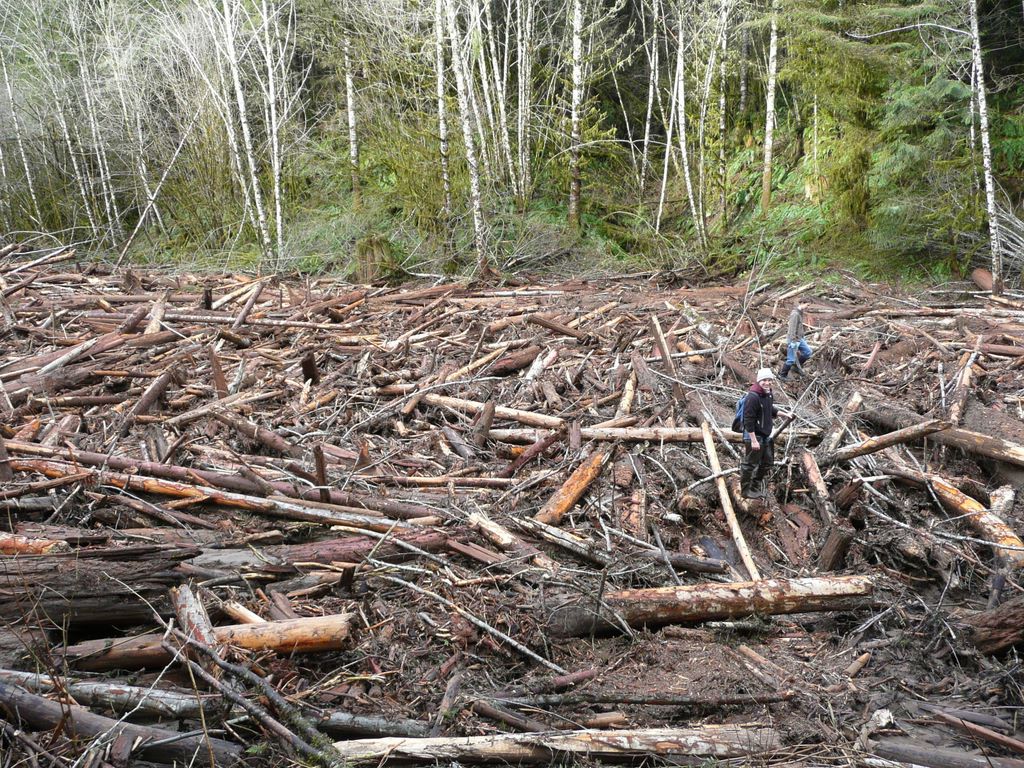
Daniel and David in the logjam.
January 2009 Agate collecting on Lucas Creek east of Centralia (area now closed)
IMPORTANT NOTE: As of Fall 2009, Weyerhaeuser has closed Lucas Creek to all agate collecting due to excessive digging in and along the stream.
In January 2009 a landlide and mudflow swept down one of the tributaries of Lucas Creek terminating in an enormous logjam. The mudflow stripped away all the vegetation and much of the topsoil from nearly two miles of the stream valley, exposing and reworking the gravel which contains most of the agate. Numerous large agate nodules, geodes and chunks of seam agate were exposed. Rockhounds were quick to discover the treasure-trove; during the two weeks following the flood, considerably more than a ton of agate was removed from the upper branches of Lucas Creek with most of that coming from the landslide fork. Little if any of that agate was found by digging - we carried shovels to fish agates and possible agates out of deeper water and to pry partially-exposed agates out of the gravel. Photos in the creek were taken over the course of half a dozen trips during January and February 2009.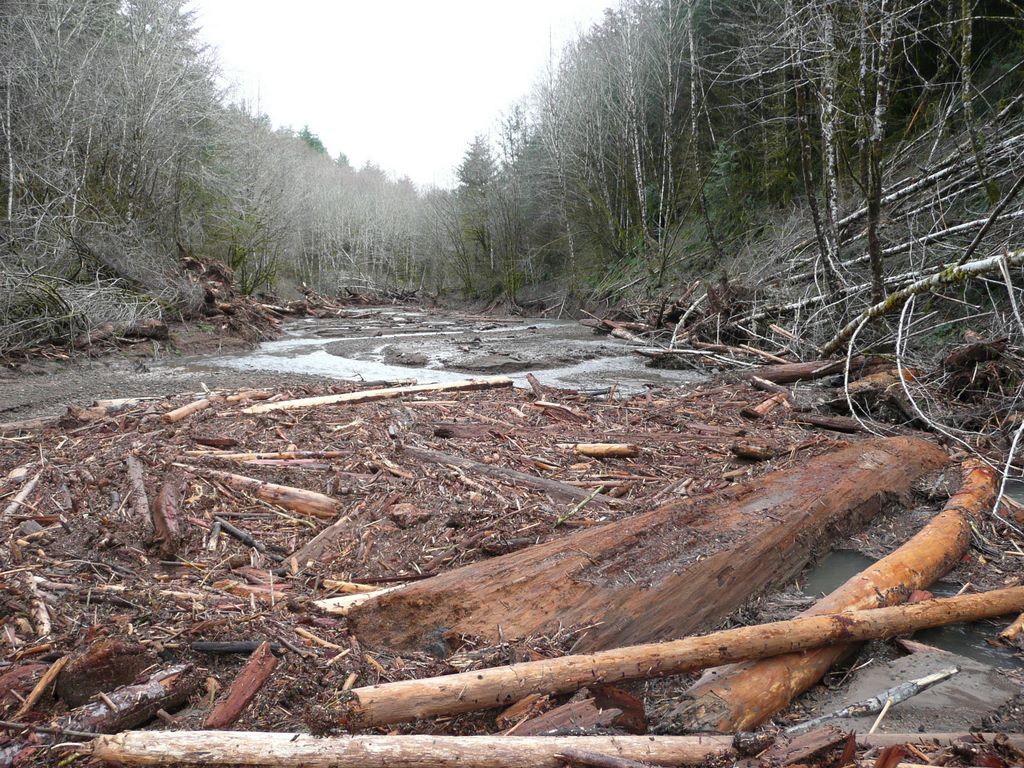
View upstream from the upper end of the logjam. This was formerly alder forest along the stream.
January 2009 Agate collecting on Lucas Creek east of Centralia (area now closed)
IMPORTANT NOTE: As of Fall 2009, Weyerhaeuser has closed Lucas Creek to all agate collecting due to excessive digging in and along the stream.
In January 2009 a landlide and mudflow swept down one of the tributaries of Lucas Creek terminating in an enormous logjam. The mudflow stripped away all the vegetation and much of the topsoil from nearly two miles of the stream valley, exposing and reworking the gravel which contains most of the agate. Numerous large agate nodules, geodes and chunks of seam agate were exposed. Rockhounds were quick to discover the treasure-trove; during the two weeks following the flood, considerably more than a ton of agate was removed from the upper branches of Lucas Creek with most of that coming from the landslide fork. Little if any of that agate was found by digging - we carried shovels to fish agates and possible agates out of deeper water and to pry partially-exposed agates out of the gravel. Photos in the creek were taken over the course of half a dozen trips during January and February 2009.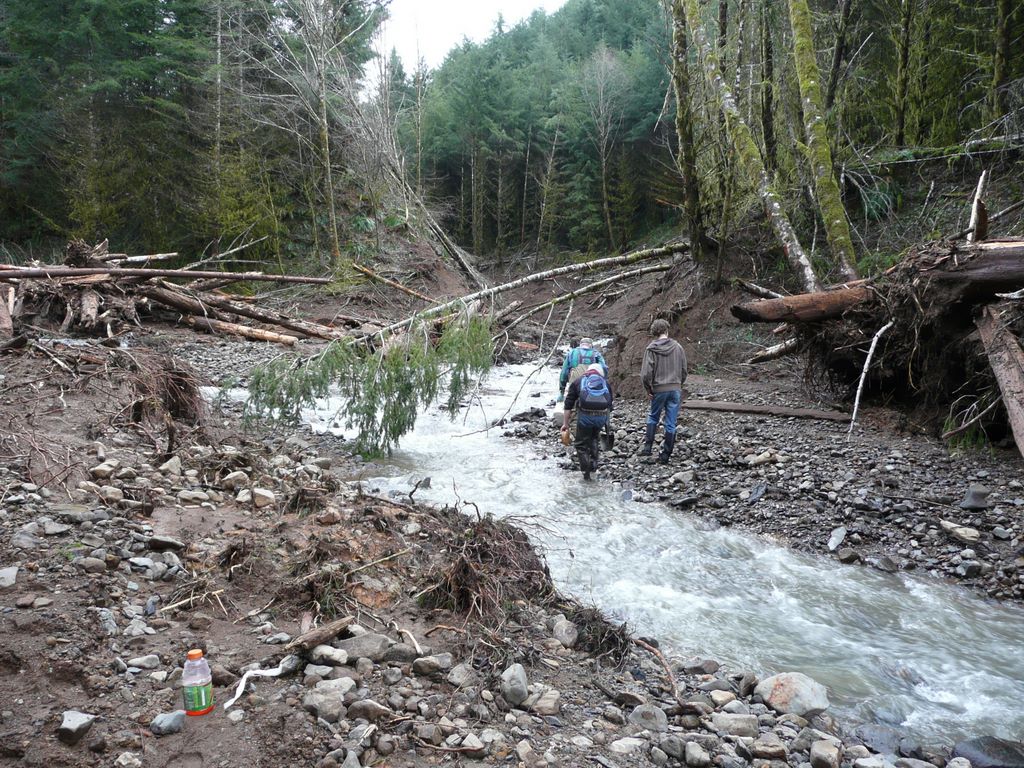
Pat, Daniel and David at the starting up the landslide tributary. Daniel is carrying a big orange agate.
January 2009 Agate collecting on Lucas Creek east of Centralia (area now closed)
IMPORTANT NOTE: As of Fall 2009, Weyerhaeuser has closed Lucas Creek to all agate collecting due to excessive digging in and along the stream.
In January 2009 a landlide and mudflow swept down one of the tributaries of Lucas Creek terminating in an enormous logjam. The mudflow stripped away all the vegetation and much of the topsoil from nearly two miles of the stream valley, exposing and reworking the gravel which contains most of the agate. Numerous large agate nodules, geodes and chunks of seam agate were exposed. Rockhounds were quick to discover the treasure-trove; during the two weeks following the flood, considerably more than a ton of agate was removed from the upper branches of Lucas Creek with most of that coming from the landslide fork. Little if any of that agate was found by digging - we carried shovels to fish agates and possible agates out of deeper water and to pry partially-exposed agates out of the gravel. Photos in the creek were taken over the course of half a dozen trips during January and February 2009.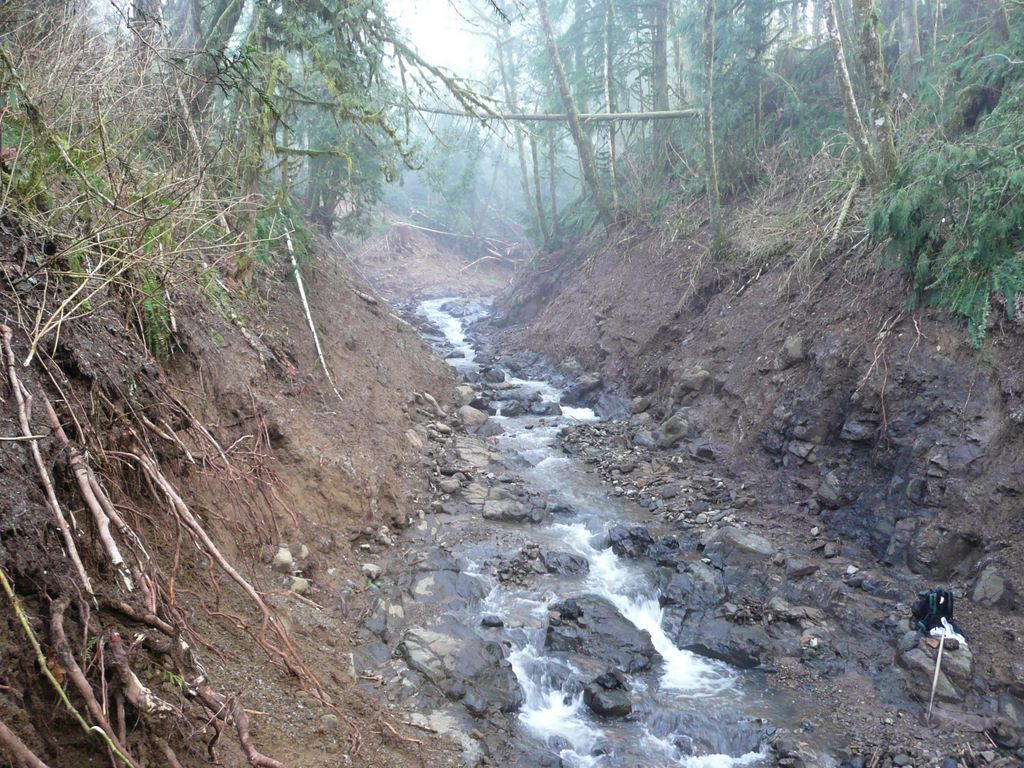
This section of the stream used to be impassable due to dense vine maple and salmonberry along with lots of fallen logs.
January 2009 Agate collecting on Lucas Creek east of Centralia (area now closed)
IMPORTANT NOTE: As of Fall 2009, Weyerhaeuser has closed Lucas Creek to all agate collecting due to excessive digging in and along the stream.
In January 2009 a landlide and mudflow swept down one of the tributaries of Lucas Creek terminating in an enormous logjam. The mudflow stripped away all the vegetation and much of the topsoil from nearly two miles of the stream valley, exposing and reworking the gravel which contains most of the agate. Numerous large agate nodules, geodes and chunks of seam agate were exposed. Rockhounds were quick to discover the treasure-trove; during the two weeks following the flood, considerably more than a ton of agate was removed from the upper branches of Lucas Creek with most of that coming from the landslide fork. Little if any of that agate was found by digging - we carried shovels to fish agates and possible agates out of deeper water and to pry partially-exposed agates out of the gravel. Photos in the creek were taken over the course of half a dozen trips during January and February 2009.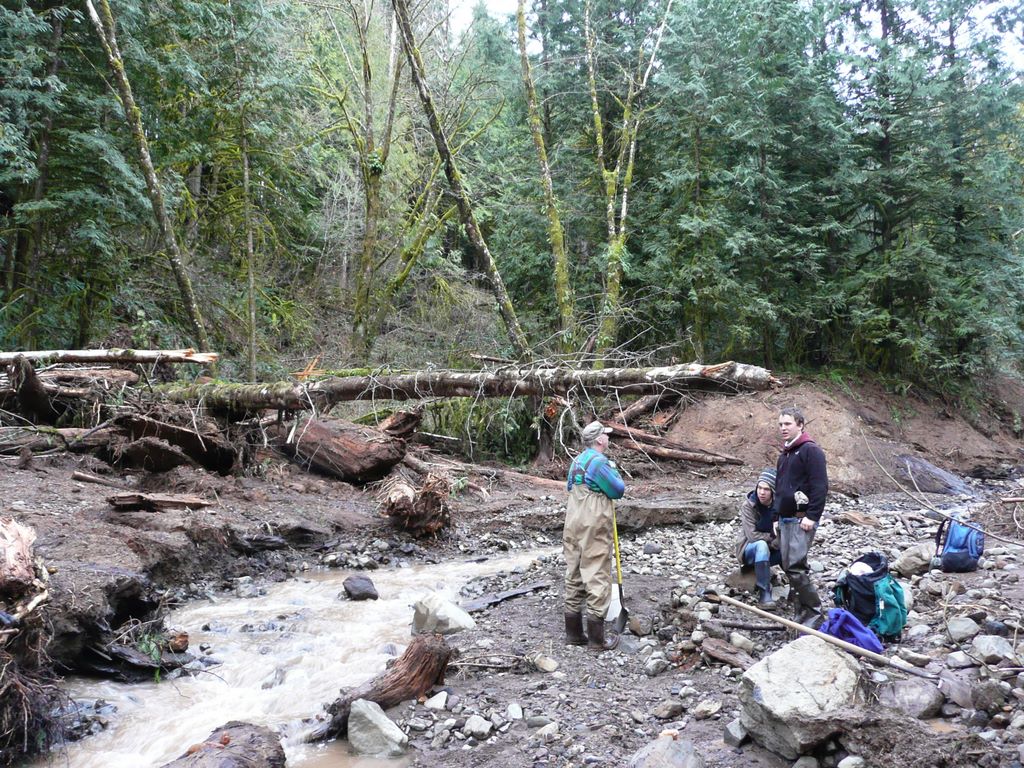
Our lunch spot the first day up the creek. In the previous 100 yards we'd found five large agates.
January 2009 Agate collecting on Lucas Creek east of Centralia (area now closed)
IMPORTANT NOTE: As of Fall 2009, Weyerhaeuser has closed Lucas Creek to all agate collecting due to excessive digging in and along the stream.
In January 2009 a landlide and mudflow swept down one of the tributaries of Lucas Creek terminating in an enormous logjam. The mudflow stripped away all the vegetation and much of the topsoil from nearly two miles of the stream valley, exposing and reworking the gravel which contains most of the agate. Numerous large agate nodules, geodes and chunks of seam agate were exposed. Rockhounds were quick to discover the treasure-trove; during the two weeks following the flood, considerably more than a ton of agate was removed from the upper branches of Lucas Creek with most of that coming from the landslide fork. Little if any of that agate was found by digging - we carried shovels to fish agates and possible agates out of deeper water and to pry partially-exposed agates out of the gravel. Photos in the creek were taken over the course of half a dozen trips during January and February 2009.
Gray agate nodule in center foreground is 6" long. I stepped over it three times before I spotted it.
January 2009 Agate collecting on Lucas Creek east of Centralia (area now closed)
IMPORTANT NOTE: As of Fall 2009, Weyerhaeuser has closed Lucas Creek to all agate collecting due to excessive digging in and along the stream.
In January 2009 a landlide and mudflow swept down one of the tributaries of Lucas Creek terminating in an enormous logjam. The mudflow stripped away all the vegetation and much of the topsoil from nearly two miles of the stream valley, exposing and reworking the gravel which contains most of the agate. Numerous large agate nodules, geodes and chunks of seam agate were exposed. Rockhounds were quick to discover the treasure-trove; during the two weeks following the flood, considerably more than a ton of agate was removed from the upper branches of Lucas Creek with most of that coming from the landslide fork. Little if any of that agate was found by digging - we carried shovels to fish agates and possible agates out of deeper water and to pry partially-exposed agates out of the gravel. Photos in the creek were taken over the course of half a dozen trips during January and February 2009.
Small chunk of seam agate on a gravel bar.
January 2009 Agate collecting on Lucas Creek east of Centralia (area now closed)
IMPORTANT NOTE: As of Fall 2009, Weyerhaeuser has closed Lucas Creek to all agate collecting due to excessive digging in and along the stream.
In January 2009 a landlide and mudflow swept down one of the tributaries of Lucas Creek terminating in an enormous logjam. The mudflow stripped away all the vegetation and much of the topsoil from nearly two miles of the stream valley, exposing and reworking the gravel which contains most of the agate. Numerous large agate nodules, geodes and chunks of seam agate were exposed. Rockhounds were quick to discover the treasure-trove; during the two weeks following the flood, considerably more than a ton of agate was removed from the upper branches of Lucas Creek with most of that coming from the landslide fork. Little if any of that agate was found by digging - we carried shovels to fish agates and possible agates out of deeper water and to pry partially-exposed agates out of the gravel. Photos in the creek were taken over the course of half a dozen trips during January and February 2009.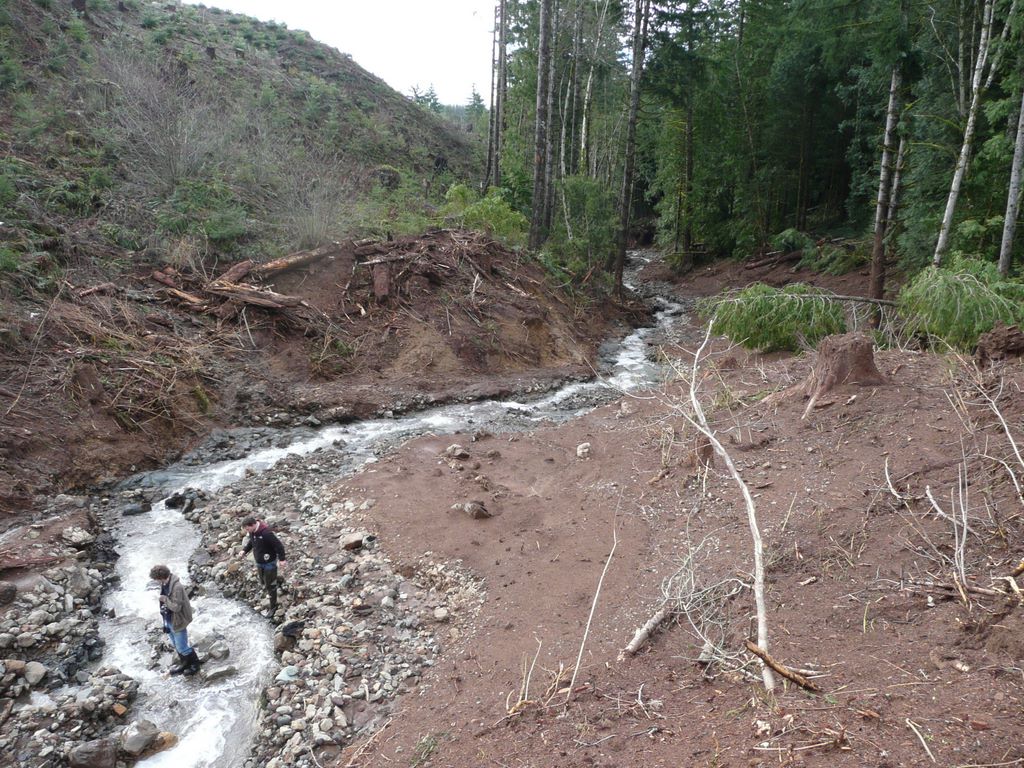
David and Daniel in the creek bed at the lower edge of the clearcut. The mudflow was about 15' deep at this point.
January 2009 Agate collecting on Lucas Creek east of Centralia (area now closed)
IMPORTANT NOTE: As of Fall 2009, Weyerhaeuser has closed Lucas Creek to all agate collecting due to excessive digging in and along the stream.
In January 2009 a landlide and mudflow swept down one of the tributaries of Lucas Creek terminating in an enormous logjam. The mudflow stripped away all the vegetation and much of the topsoil from nearly two miles of the stream valley, exposing and reworking the gravel which contains most of the agate. Numerous large agate nodules, geodes and chunks of seam agate were exposed. Rockhounds were quick to discover the treasure-trove; during the two weeks following the flood, considerably more than a ton of agate was removed from the upper branches of Lucas Creek with most of that coming from the landslide fork. Little if any of that agate was found by digging - we carried shovels to fish agates and possible agates out of deeper water and to pry partially-exposed agates out of the gravel. Photos in the creek were taken over the course of half a dozen trips during January and February 2009.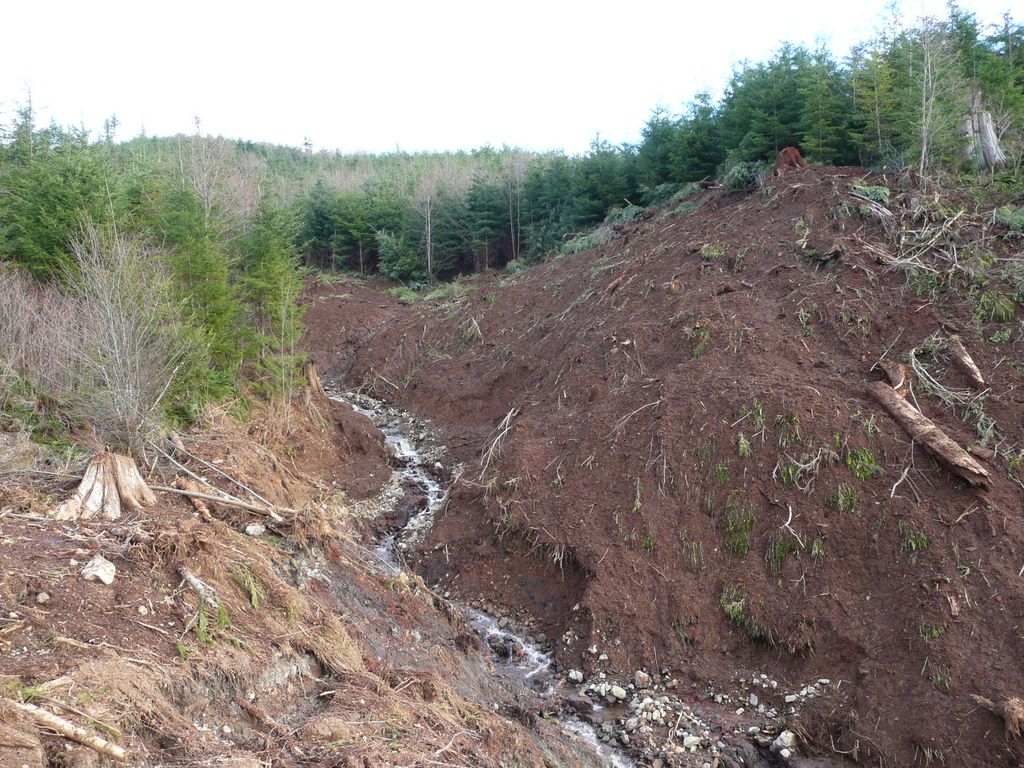
The mudflow ricocheted off the bank on the right side of the stream and spread out across the clearcut behind me. The log at the right edge of the photo is about 10' long.
January 2009 Agate collecting on Lucas Creek east of Centralia (area now closed)
IMPORTANT NOTE: As of Fall 2009, Weyerhaeuser has closed Lucas Creek to all agate collecting due to excessive digging in and along the stream.
In January 2009 a landlide and mudflow swept down one of the tributaries of Lucas Creek terminating in an enormous logjam. The mudflow stripped away all the vegetation and much of the topsoil from nearly two miles of the stream valley, exposing and reworking the gravel which contains most of the agate. Numerous large agate nodules, geodes and chunks of seam agate were exposed. Rockhounds were quick to discover the treasure-trove; during the two weeks following the flood, considerably more than a ton of agate was removed from the upper branches of Lucas Creek with most of that coming from the landslide fork. Little if any of that agate was found by digging - we carried shovels to fish agates and possible agates out of deeper water and to pry partially-exposed agates out of the gravel. Photos in the creek were taken over the course of half a dozen trips during January and February 2009.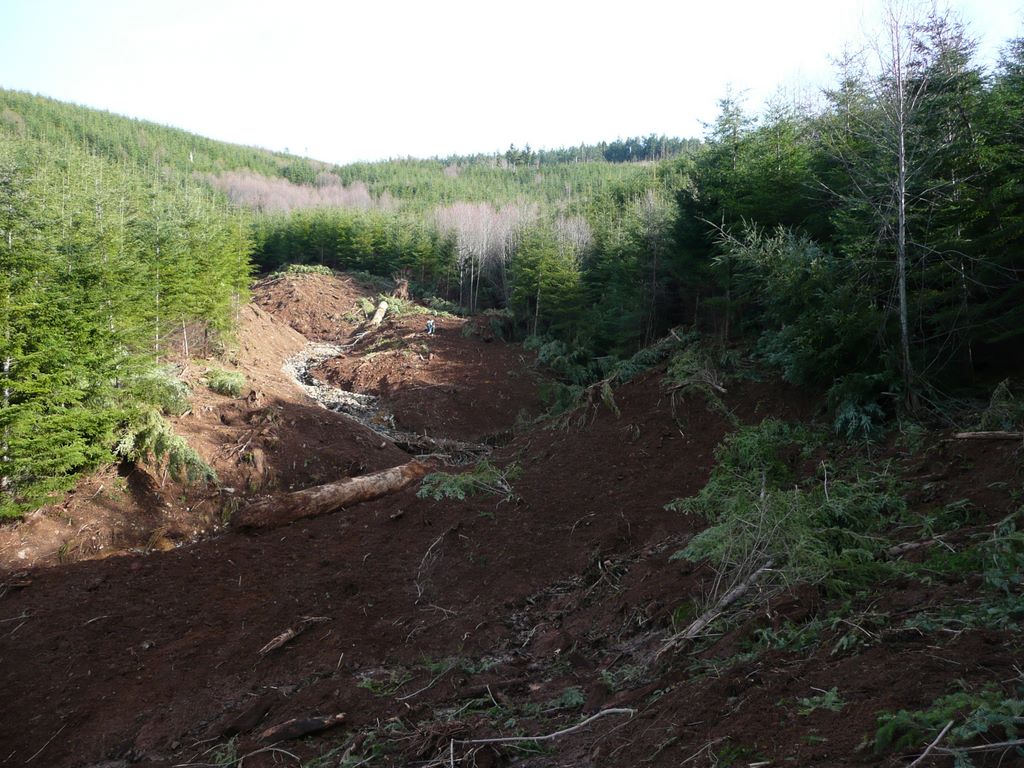
View up the stream valley about a quarter mile below the landslide. Pat is at the edge of the shadows near the center of the photo.
January 2009 Agate collecting on Lucas Creek east of Centralia (area now closed)
IMPORTANT NOTE: As of Fall 2009, Weyerhaeuser has closed Lucas Creek to all agate collecting due to excessive digging in and along the stream.
In January 2009 a landlide and mudflow swept down one of the tributaries of Lucas Creek terminating in an enormous logjam. The mudflow stripped away all the vegetation and much of the topsoil from nearly two miles of the stream valley, exposing and reworking the gravel which contains most of the agate. Numerous large agate nodules, geodes and chunks of seam agate were exposed. Rockhounds were quick to discover the treasure-trove; during the two weeks following the flood, considerably more than a ton of agate was removed from the upper branches of Lucas Creek with most of that coming from the landslide fork. Little if any of that agate was found by digging - we carried shovels to fish agates and possible agates out of deeper water and to pry partially-exposed agates out of the gravel. Photos in the creek were taken over the course of half a dozen trips during January and February 2009.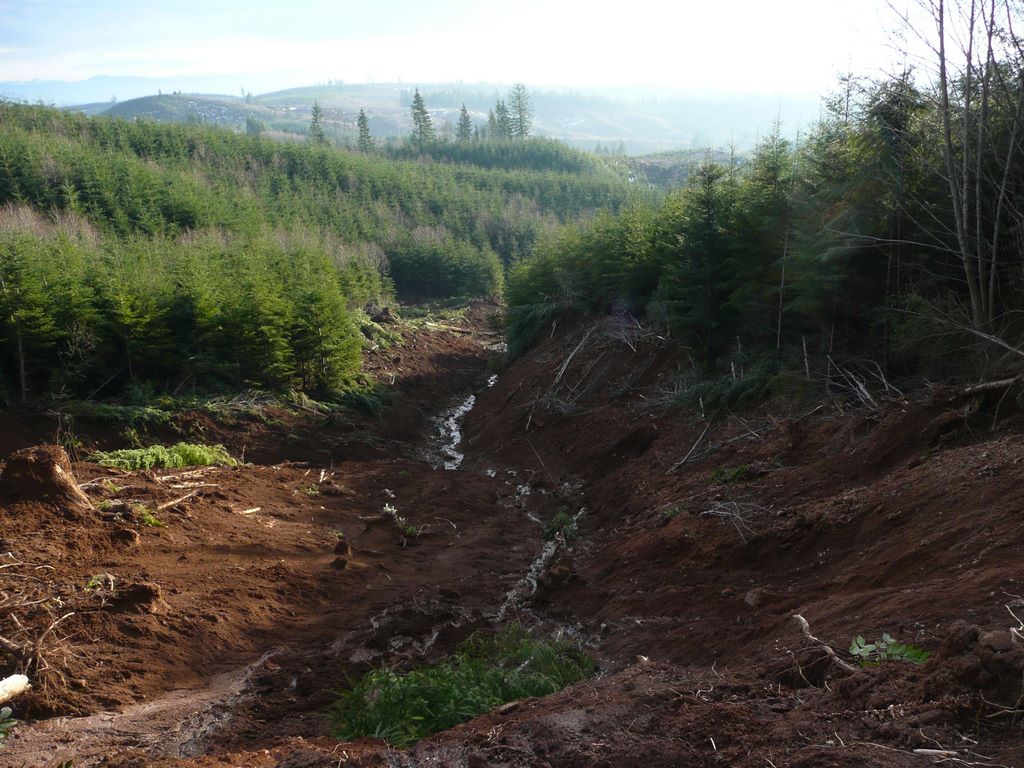
View down the stream valley from the upper part of the landslide.
January 2009 Agate collecting on Lucas Creek east of Centralia (area now closed)
IMPORTANT NOTE: As of Fall 2009, Weyerhaeuser has closed Lucas Creek to all agate collecting due to excessive digging in and along the stream.
In January 2009 a landlide and mudflow swept down one of the tributaries of Lucas Creek terminating in an enormous logjam. The mudflow stripped away all the vegetation and much of the topsoil from nearly two miles of the stream valley, exposing and reworking the gravel which contains most of the agate. Numerous large agate nodules, geodes and chunks of seam agate were exposed. Rockhounds were quick to discover the treasure-trove; during the two weeks following the flood, considerably more than a ton of agate was removed from the upper branches of Lucas Creek with most of that coming from the landslide fork. Little if any of that agate was found by digging - we carried shovels to fish agates and possible agates out of deeper water and to pry partially-exposed agates out of the gravel. Photos in the creek were taken over the course of half a dozen trips during January and February 2009.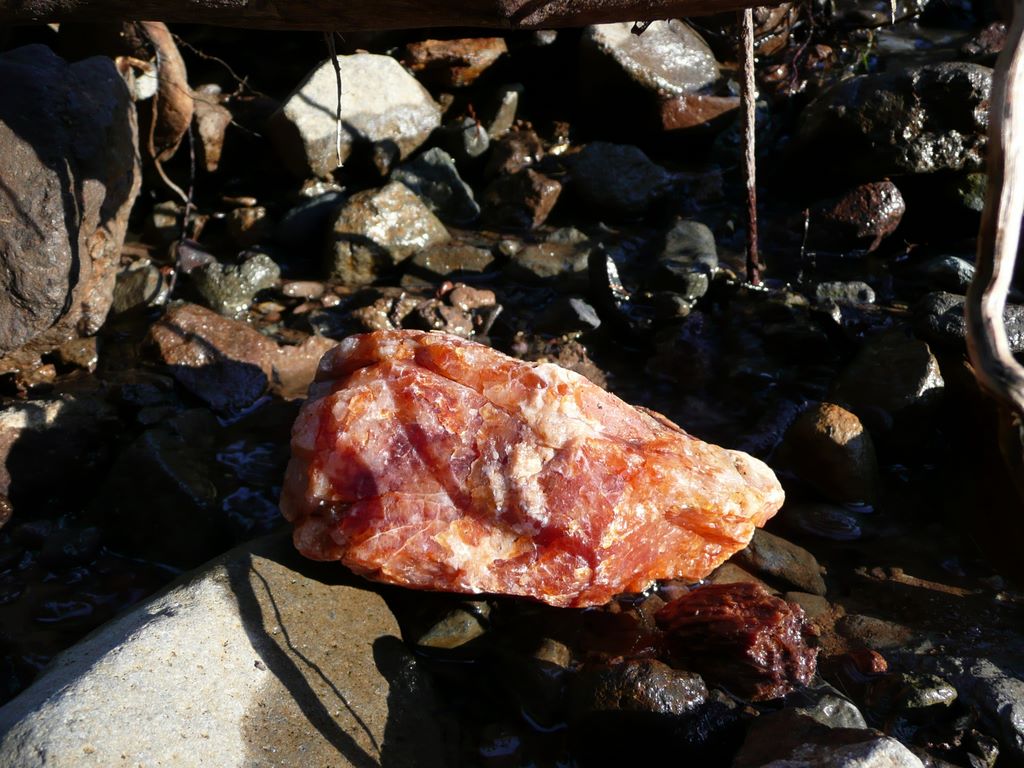
Small orange seam agate
January 2009 Agate collecting on Lucas Creek east of Centralia (area now closed)
IMPORTANT NOTE: As of Fall 2009, Weyerhaeuser has closed Lucas Creek to all agate collecting due to excessive digging in and along the stream.
In January 2009 a landlide and mudflow swept down one of the tributaries of Lucas Creek terminating in an enormous logjam. The mudflow stripped away all the vegetation and much of the topsoil from nearly two miles of the stream valley, exposing and reworking the gravel which contains most of the agate. Numerous large agate nodules, geodes and chunks of seam agate were exposed. Rockhounds were quick to discover the treasure-trove; during the two weeks following the flood, considerably more than a ton of agate was removed from the upper branches of Lucas Creek with most of that coming from the landslide fork. Little if any of that agate was found by digging - we carried shovels to fish agates and possible agates out of deeper water and to pry partially-exposed agates out of the gravel. Photos in the creek were taken over the course of half a dozen trips during January and February 2009.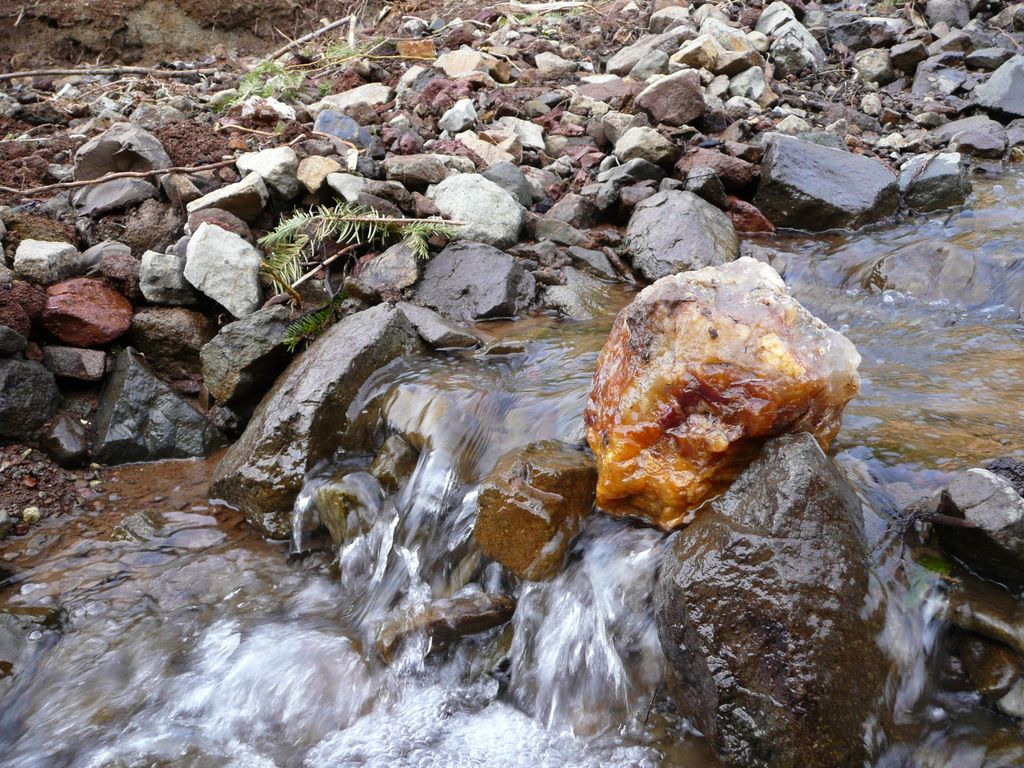
6" chunk of seam agate in the stream.
January 2009 Agate collecting on Lucas Creek east of Centralia (area now closed)
IMPORTANT NOTE: As of Fall 2009, Weyerhaeuser has closed Lucas Creek to all agate collecting due to excessive digging in and along the stream.
In January 2009 a landlide and mudflow swept down one of the tributaries of Lucas Creek terminating in an enormous logjam. The mudflow stripped away all the vegetation and much of the topsoil from nearly two miles of the stream valley, exposing and reworking the gravel which contains most of the agate. Numerous large agate nodules, geodes and chunks of seam agate were exposed. Rockhounds were quick to discover the treasure-trove; during the two weeks following the flood, considerably more than a ton of agate was removed from the upper branches of Lucas Creek with most of that coming from the landslide fork. Little if any of that agate was found by digging - we carried shovels to fish agates and possible agates out of deeper water and to pry partially-exposed agates out of the gravel. Photos in the creek were taken over the course of half a dozen trips during January and February 2009.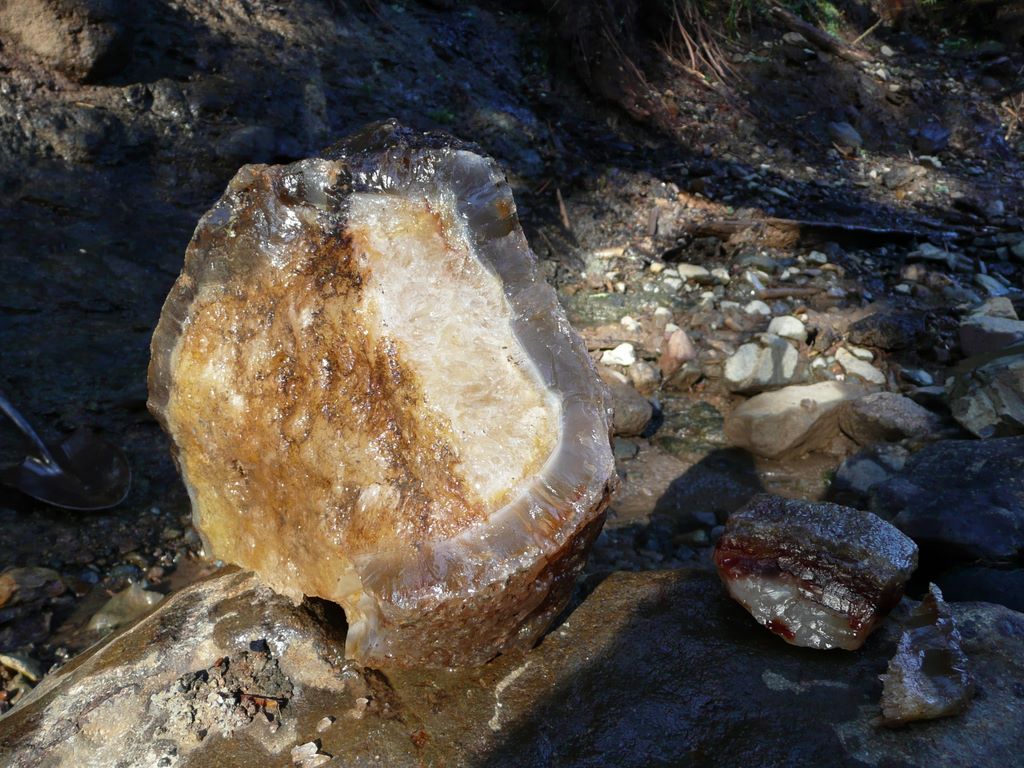
Pat's broken geode about 8" across.
January 2009 Agate collecting on Lucas Creek east of Centralia (area now closed)
IMPORTANT NOTE: As of Fall 2009, Weyerhaeuser has closed Lucas Creek to all agate collecting due to excessive digging in and along the stream.
In January 2009 a landlide and mudflow swept down one of the tributaries of Lucas Creek terminating in an enormous logjam. The mudflow stripped away all the vegetation and much of the topsoil from nearly two miles of the stream valley, exposing and reworking the gravel which contains most of the agate. Numerous large agate nodules, geodes and chunks of seam agate were exposed. Rockhounds were quick to discover the treasure-trove; during the two weeks following the flood, considerably more than a ton of agate was removed from the upper branches of Lucas Creek with most of that coming from the landslide fork. Little if any of that agate was found by digging - we carried shovels to fish agates and possible agates out of deeper water and to pry partially-exposed agates out of the gravel. Photos in the creek were taken over the course of half a dozen trips during January and February 2009.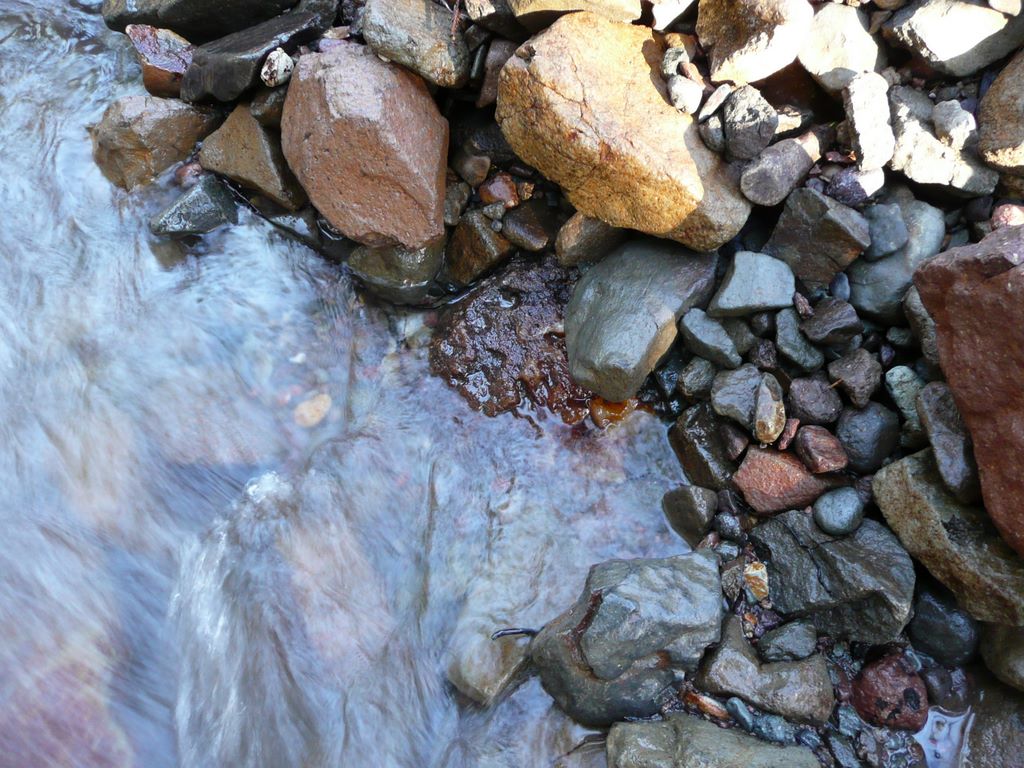
Notice the large agate in the center of the photo, partially in the water.
January 2009 Agate collecting on Lucas Creek east of Centralia (area now closed)
IMPORTANT NOTE: As of Fall 2009, Weyerhaeuser has closed Lucas Creek to all agate collecting due to excessive digging in and along the stream.
In January 2009 a landlide and mudflow swept down one of the tributaries of Lucas Creek terminating in an enormous logjam. The mudflow stripped away all the vegetation and much of the topsoil from nearly two miles of the stream valley, exposing and reworking the gravel which contains most of the agate. Numerous large agate nodules, geodes and chunks of seam agate were exposed. Rockhounds were quick to discover the treasure-trove; during the two weeks following the flood, considerably more than a ton of agate was removed from the upper branches of Lucas Creek with most of that coming from the landslide fork. Little if any of that agate was found by digging - we carried shovels to fish agates and possible agates out of deeper water and to pry partially-exposed agates out of the gravel. Photos in the creek were taken over the course of half a dozen trips during January and February 2009.
The agate in the previous photo turned out to be this 21 pound geode. Although complete, the agate rind is very thin.
January 2009 Agate collecting on Lucas Creek east of Centralia (area now closed)
IMPORTANT NOTE: As of Fall 2009, Weyerhaeuser has closed Lucas Creek to all agate collecting due to excessive digging in and along the stream.
In January 2009 a landlide and mudflow swept down one of the tributaries of Lucas Creek terminating in an enormous logjam. The mudflow stripped away all the vegetation and much of the topsoil from nearly two miles of the stream valley, exposing and reworking the gravel which contains most of the agate. Numerous large agate nodules, geodes and chunks of seam agate were exposed. Rockhounds were quick to discover the treasure-trove; during the two weeks following the flood, considerably more than a ton of agate was removed from the upper branches of Lucas Creek with most of that coming from the landslide fork. Little if any of that agate was found by digging - we carried shovels to fish agates and possible agates out of deeper water and to pry partially-exposed agates out of the gravel. Photos in the creek were taken over the course of half a dozen trips during January and February 2009.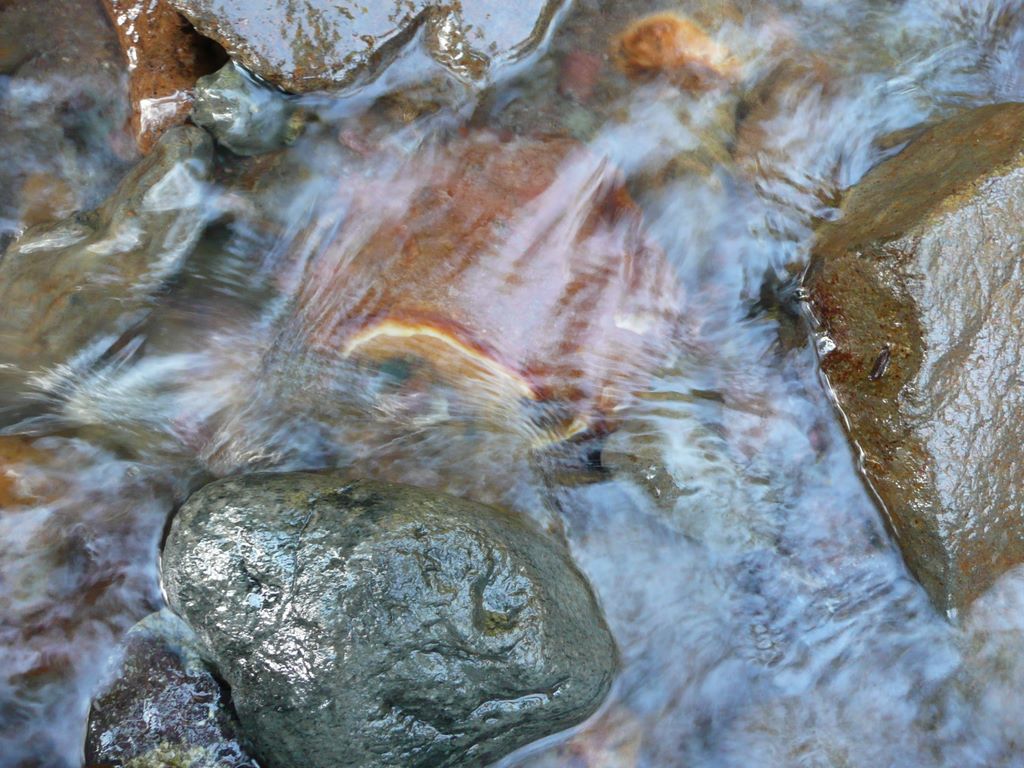
Another orange and yellow geode where I found it in the stream.
January 2009 Agate collecting on Lucas Creek east of Centralia (area now closed)
IMPORTANT NOTE: As of Fall 2009, Weyerhaeuser has closed Lucas Creek to all agate collecting due to excessive digging in and along the stream.
In January 2009 a landlide and mudflow swept down one of the tributaries of Lucas Creek terminating in an enormous logjam. The mudflow stripped away all the vegetation and much of the topsoil from nearly two miles of the stream valley, exposing and reworking the gravel which contains most of the agate. Numerous large agate nodules, geodes and chunks of seam agate were exposed. Rockhounds were quick to discover the treasure-trove; during the two weeks following the flood, considerably more than a ton of agate was removed from the upper branches of Lucas Creek with most of that coming from the landslide fork. Little if any of that agate was found by digging - we carried shovels to fish agates and possible agates out of deeper water and to pry partially-exposed agates out of the gravel. Photos in the creek were taken over the course of half a dozen trips during January and February 2009.
Here's the geode from the previous image. It's about 5" across. Here's what it looks on the inside, cut and polished.
January 2009 Agate collecting on Lucas Creek east of Centralia (area now closed)
IMPORTANT NOTE: As of Fall 2009, Weyerhaeuser has closed Lucas Creek to all agate collecting due to excessive digging in and along the stream.
In January 2009 a landlide and mudflow swept down one of the tributaries of Lucas Creek terminating in an enormous logjam. The mudflow stripped away all the vegetation and much of the topsoil from nearly two miles of the stream valley, exposing and reworking the gravel which contains most of the agate. Numerous large agate nodules, geodes and chunks of seam agate were exposed. Rockhounds were quick to discover the treasure-trove; during the two weeks following the flood, considerably more than a ton of agate was removed from the upper branches of Lucas Creek with most of that coming from the landslide fork. Little if any of that agate was found by digging - we carried shovels to fish agates and possible agates out of deeper water and to pry partially-exposed agates out of the gravel. Photos in the creek were taken over the course of half a dozen trips during January and February 2009.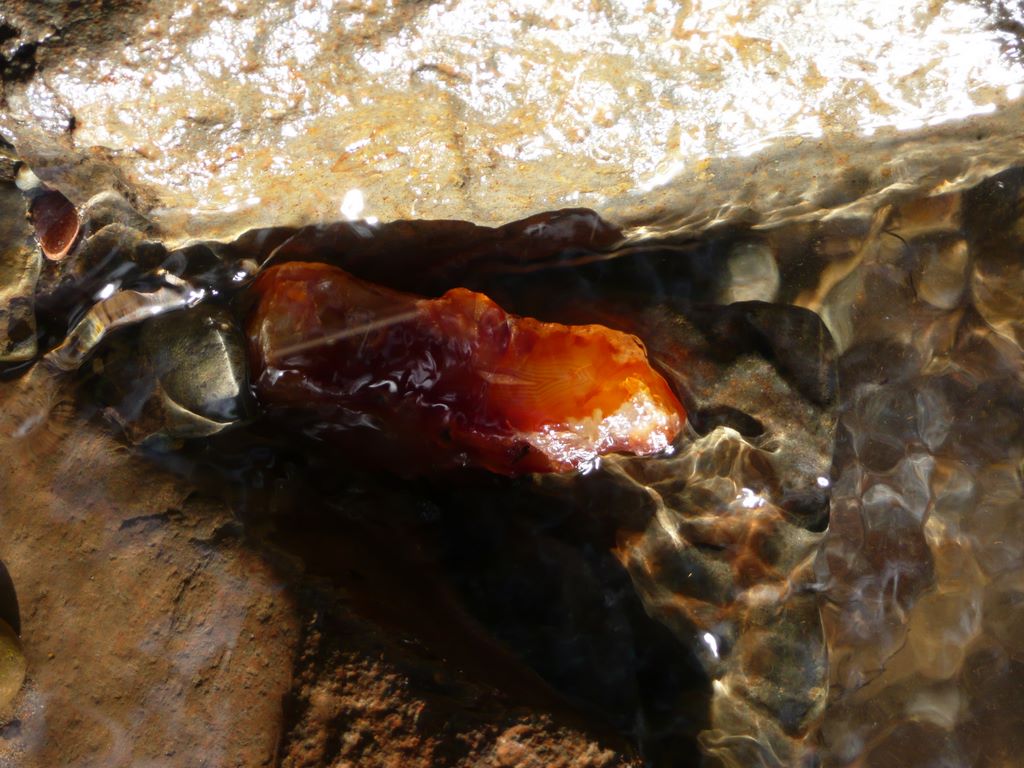
A small red agate in the stream. It's only about 2" across so we left it there.
January 2009 Agate collecting on Lucas Creek east of Centralia (area now closed)
IMPORTANT NOTE: As of Fall 2009, Weyerhaeuser has closed Lucas Creek to all agate collecting due to excessive digging in and along the stream.
In January 2009 a landlide and mudflow swept down one of the tributaries of Lucas Creek terminating in an enormous logjam. The mudflow stripped away all the vegetation and much of the topsoil from nearly two miles of the stream valley, exposing and reworking the gravel which contains most of the agate. Numerous large agate nodules, geodes and chunks of seam agate were exposed. Rockhounds were quick to discover the treasure-trove; during the two weeks following the flood, considerably more than a ton of agate was removed from the upper branches of Lucas Creek with most of that coming from the landslide fork. Little if any of that agate was found by digging - we carried shovels to fish agates and possible agates out of deeper water and to pry partially-exposed agates out of the gravel. Photos in the creek were taken over the course of half a dozen trips during January and February 2009.
Another small banded red agate, this time in one of the smaller tributaries.
January 2009 Agate collecting on Lucas Creek east of Centralia (area now closed)
IMPORTANT NOTE: As of Fall 2009, Weyerhaeuser has closed Lucas Creek to all agate collecting due to excessive digging in and along the stream.
In January 2009 a landlide and mudflow swept down one of the tributaries of Lucas Creek terminating in an enormous logjam. The mudflow stripped away all the vegetation and much of the topsoil from nearly two miles of the stream valley, exposing and reworking the gravel which contains most of the agate. Numerous large agate nodules, geodes and chunks of seam agate were exposed. Rockhounds were quick to discover the treasure-trove; during the two weeks following the flood, considerably more than a ton of agate was removed from the upper branches of Lucas Creek with most of that coming from the landslide fork. Little if any of that agate was found by digging - we carried shovels to fish agates and possible agates out of deeper water and to pry partially-exposed agates out of the gravel. Photos in the creek were taken over the course of half a dozen trips during January and February 2009.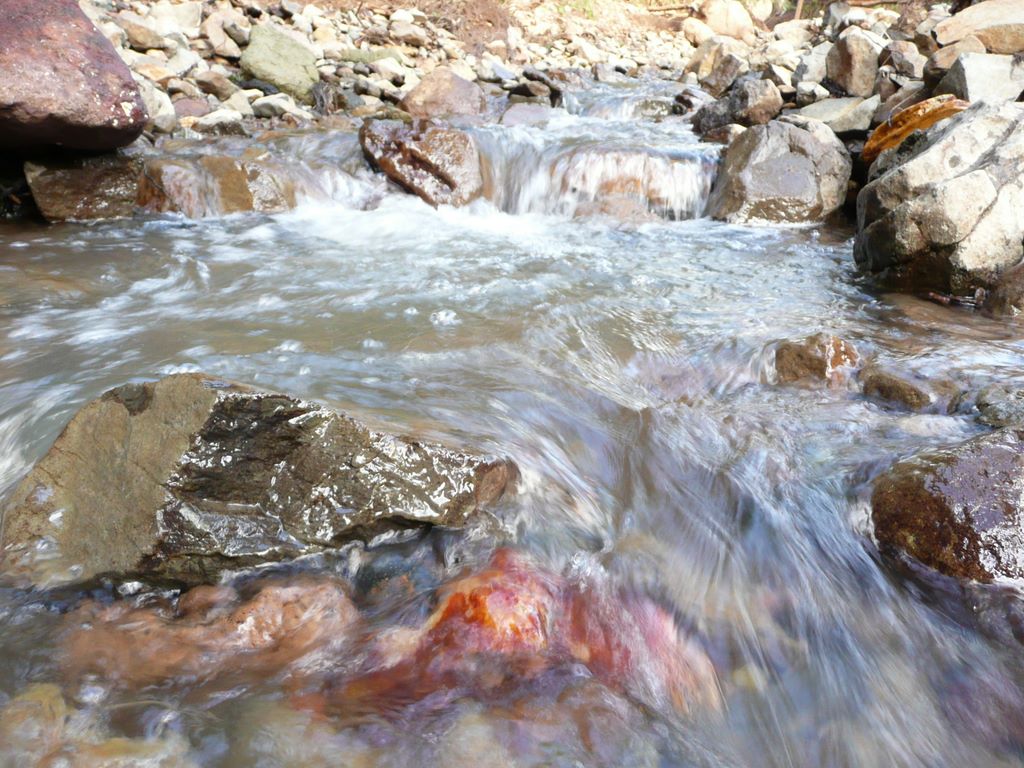
This agate, in the landslide tributary, turned out to be a 15 pound open geode with a thick dark red agate rind.
January 2009 Agate collecting on Lucas Creek east of Centralia (area now closed)
IMPORTANT NOTE: As of Fall 2009, Weyerhaeuser has closed Lucas Creek to all agate collecting due to excessive digging in and along the stream.
In January 2009 a landlide and mudflow swept down one of the tributaries of Lucas Creek terminating in an enormous logjam. The mudflow stripped away all the vegetation and much of the topsoil from nearly two miles of the stream valley, exposing and reworking the gravel which contains most of the agate. Numerous large agate nodules, geodes and chunks of seam agate were exposed. Rockhounds were quick to discover the treasure-trove; during the two weeks following the flood, considerably more than a ton of agate was removed from the upper branches of Lucas Creek with most of that coming from the landslide fork. Little if any of that agate was found by digging - we carried shovels to fish agates and possible agates out of deeper water and to pry partially-exposed agates out of the gravel. Photos in the creek were taken over the course of half a dozen trips during January and February 2009.
4" broken geode as I found it.
January 2009 Agate collecting on Lucas Creek east of Centralia (area now closed)
IMPORTANT NOTE: As of Fall 2009, Weyerhaeuser has closed Lucas Creek to all agate collecting due to excessive digging in and along the stream.
In January 2009 a landlide and mudflow swept down one of the tributaries of Lucas Creek terminating in an enormous logjam. The mudflow stripped away all the vegetation and much of the topsoil from nearly two miles of the stream valley, exposing and reworking the gravel which contains most of the agate. Numerous large agate nodules, geodes and chunks of seam agate were exposed. Rockhounds were quick to discover the treasure-trove; during the two weeks following the flood, considerably more than a ton of agate was removed from the upper branches of Lucas Creek with most of that coming from the landslide fork. Little if any of that agate was found by digging - we carried shovels to fish agates and possible agates out of deeper water and to pry partially-exposed agates out of the gravel. Photos in the creek were taken over the course of half a dozen trips during January and February 2009.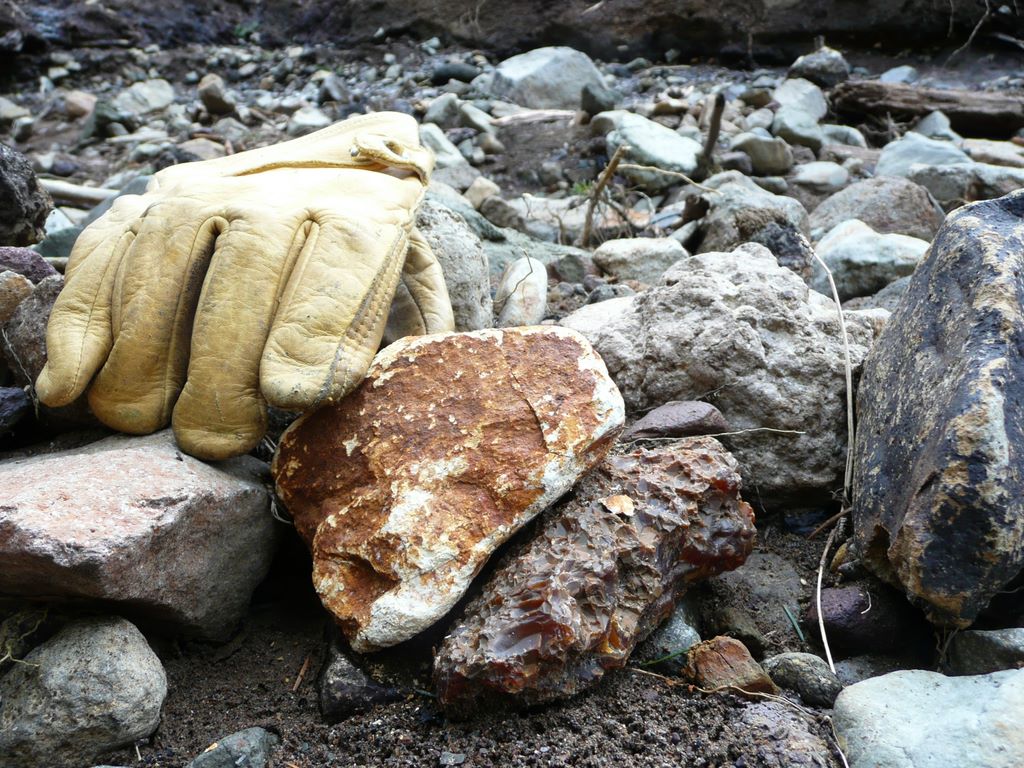
Another 4" chunk of carnelian. The sharp edges on the outide of this piece indicate that it has not traveled far in the stream.
January 2009 Agate collecting on Lucas Creek east of Centralia (area now closed)
IMPORTANT NOTE: As of Fall 2009, Weyerhaeuser has closed Lucas Creek to all agate collecting due to excessive digging in and along the stream.
In January 2009 a landlide and mudflow swept down one of the tributaries of Lucas Creek terminating in an enormous logjam. The mudflow stripped away all the vegetation and much of the topsoil from nearly two miles of the stream valley, exposing and reworking the gravel which contains most of the agate. Numerous large agate nodules, geodes and chunks of seam agate were exposed. Rockhounds were quick to discover the treasure-trove; during the two weeks following the flood, considerably more than a ton of agate was removed from the upper branches of Lucas Creek with most of that coming from the landslide fork. Little if any of that agate was found by digging - we carried shovels to fish agates and possible agates out of deeper water and to pry partially-exposed agates out of the gravel. Photos in the creek were taken over the course of half a dozen trips during January and February 2009.
Agate nodule about 4" across. Here's what the interior looks like.
January 2009 Agate collecting on Lucas Creek east of Centralia (area now closed)
IMPORTANT NOTE: As of Fall 2009, Weyerhaeuser has closed Lucas Creek to all agate collecting due to excessive digging in and along the stream.
In January 2009 a landlide and mudflow swept down one of the tributaries of Lucas Creek terminating in an enormous logjam. The mudflow stripped away all the vegetation and much of the topsoil from nearly two miles of the stream valley, exposing and reworking the gravel which contains most of the agate. Numerous large agate nodules, geodes and chunks of seam agate were exposed. Rockhounds were quick to discover the treasure-trove; during the two weeks following the flood, considerably more than a ton of agate was removed from the upper branches of Lucas Creek with most of that coming from the landslide fork. Little if any of that agate was found by digging - we carried shovels to fish agates and possible agates out of deeper water and to pry partially-exposed agates out of the gravel. Photos in the creek were taken over the course of half a dozen trips during January and February 2009.
Small gray and orange agate nodule, about 4" wide by only 1" thick.
January 2009 Agate collecting on Lucas Creek east of Centralia (area now closed)
IMPORTANT NOTE: As of Fall 2009, Weyerhaeuser has closed Lucas Creek to all agate collecting due to excessive digging in and along the stream.
In January 2009 a landlide and mudflow swept down one of the tributaries of Lucas Creek terminating in an enormous logjam. The mudflow stripped away all the vegetation and much of the topsoil from nearly two miles of the stream valley, exposing and reworking the gravel which contains most of the agate. Numerous large agate nodules, geodes and chunks of seam agate were exposed. Rockhounds were quick to discover the treasure-trove; during the two weeks following the flood, considerably more than a ton of agate was removed from the upper branches of Lucas Creek with most of that coming from the landslide fork. Little if any of that agate was found by digging - we carried shovels to fish agates and possible agates out of deeper water and to pry partially-exposed agates out of the gravel. Photos in the creek were taken over the course of half a dozen trips during January and February 2009.
Can you spot the agate hiding under the end of the log?
January 2009 Agate collecting on Lucas Creek east of Centralia (area now closed)
IMPORTANT NOTE: As of Fall 2009, Weyerhaeuser has closed Lucas Creek to all agate collecting due to excessive digging in and along the stream.
In January 2009 a landlide and mudflow swept down one of the tributaries of Lucas Creek terminating in an enormous logjam. The mudflow stripped away all the vegetation and much of the topsoil from nearly two miles of the stream valley, exposing and reworking the gravel which contains most of the agate. Numerous large agate nodules, geodes and chunks of seam agate were exposed. Rockhounds were quick to discover the treasure-trove; during the two weeks following the flood, considerably more than a ton of agate was removed from the upper branches of Lucas Creek with most of that coming from the landslide fork. Little if any of that agate was found by digging - we carried shovels to fish agates and possible agates out of deeper water and to pry partially-exposed agates out of the gravel. Photos in the creek were taken over the course of half a dozen trips during January and February 2009.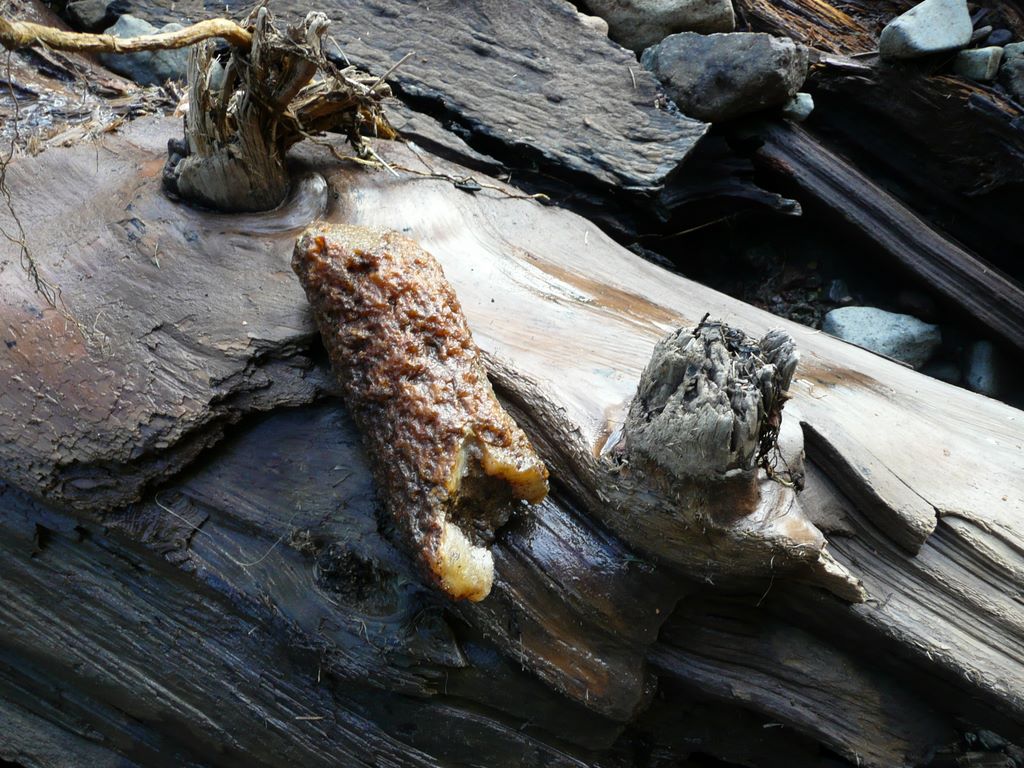
Here it is, about 5" long, a tube of yellowish gray agate with quartz in the center.
January 2009 Agate collecting on Lucas Creek east of Centralia (area now closed)
IMPORTANT NOTE: As of Fall 2009, Weyerhaeuser has closed Lucas Creek to all agate collecting due to excessive digging in and along the stream.
In January 2009 a landlide and mudflow swept down one of the tributaries of Lucas Creek terminating in an enormous logjam. The mudflow stripped away all the vegetation and much of the topsoil from nearly two miles of the stream valley, exposing and reworking the gravel which contains most of the agate. Numerous large agate nodules, geodes and chunks of seam agate were exposed. Rockhounds were quick to discover the treasure-trove; during the two weeks following the flood, considerably more than a ton of agate was removed from the upper branches of Lucas Creek with most of that coming from the landslide fork. Little if any of that agate was found by digging - we carried shovels to fish agates and possible agates out of deeper water and to pry partially-exposed agates out of the gravel. Photos in the creek were taken over the course of half a dozen trips during January and February 2009.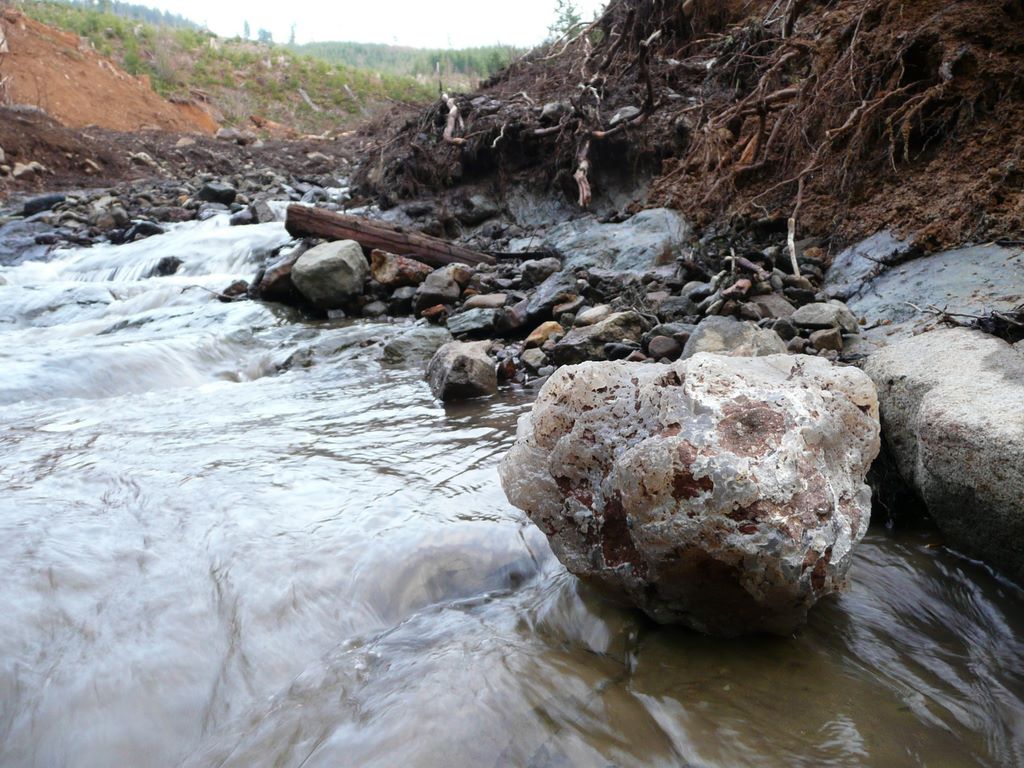
Large gray agate nodule in the stream at the lower edge of the clearcut. Another broken geode sits right in front of the log above and to the left of the gray agate.
January 2009 Agate collecting on Lucas Creek east of Centralia (area now closed)
IMPORTANT NOTE: As of Fall 2009, Weyerhaeuser has closed Lucas Creek to all agate collecting due to excessive digging in and along the stream.
In January 2009 a landlide and mudflow swept down one of the tributaries of Lucas Creek terminating in an enormous logjam. The mudflow stripped away all the vegetation and much of the topsoil from nearly two miles of the stream valley, exposing and reworking the gravel which contains most of the agate. Numerous large agate nodules, geodes and chunks of seam agate were exposed. Rockhounds were quick to discover the treasure-trove; during the two weeks following the flood, considerably more than a ton of agate was removed from the upper branches of Lucas Creek with most of that coming from the landslide fork. Little if any of that agate was found by digging - we carried shovels to fish agates and possible agates out of deeper water and to pry partially-exposed agates out of the gravel. Photos in the creek were taken over the course of half a dozen trips during January and February 2009.
The top of an agate is just barely exposed in the center of this photo.
January 2009 Agate collecting on Lucas Creek east of Centralia (area now closed)
IMPORTANT NOTE: As of Fall 2009, Weyerhaeuser has closed Lucas Creek to all agate collecting due to excessive digging in and along the stream.
In January 2009 a landlide and mudflow swept down one of the tributaries of Lucas Creek terminating in an enormous logjam. The mudflow stripped away all the vegetation and much of the topsoil from nearly two miles of the stream valley, exposing and reworking the gravel which contains most of the agate. Numerous large agate nodules, geodes and chunks of seam agate were exposed. Rockhounds were quick to discover the treasure-trove; during the two weeks following the flood, considerably more than a ton of agate was removed from the upper branches of Lucas Creek with most of that coming from the landslide fork. Little if any of that agate was found by digging - we carried shovels to fish agates and possible agates out of deeper water and to pry partially-exposed agates out of the gravel. Photos in the creek were taken over the course of half a dozen trips during January and February 2009.
It turned out to be a large nodule or geode; I won't know which until I cut it.
January 2009 Agate collecting on Lucas Creek east of Centralia (area now closed)
IMPORTANT NOTE: As of Fall 2009, Weyerhaeuser has closed Lucas Creek to all agate collecting due to excessive digging in and along the stream.
In January 2009 a landlide and mudflow swept down one of the tributaries of Lucas Creek terminating in an enormous logjam. The mudflow stripped away all the vegetation and much of the topsoil from nearly two miles of the stream valley, exposing and reworking the gravel which contains most of the agate. Numerous large agate nodules, geodes and chunks of seam agate were exposed. Rockhounds were quick to discover the treasure-trove; during the two weeks following the flood, considerably more than a ton of agate was removed from the upper branches of Lucas Creek with most of that coming from the landslide fork. Little if any of that agate was found by digging - we carried shovels to fish agates and possible agates out of deeper water and to pry partially-exposed agates out of the gravel. Photos in the creek were taken over the course of half a dozen trips during January and February 2009.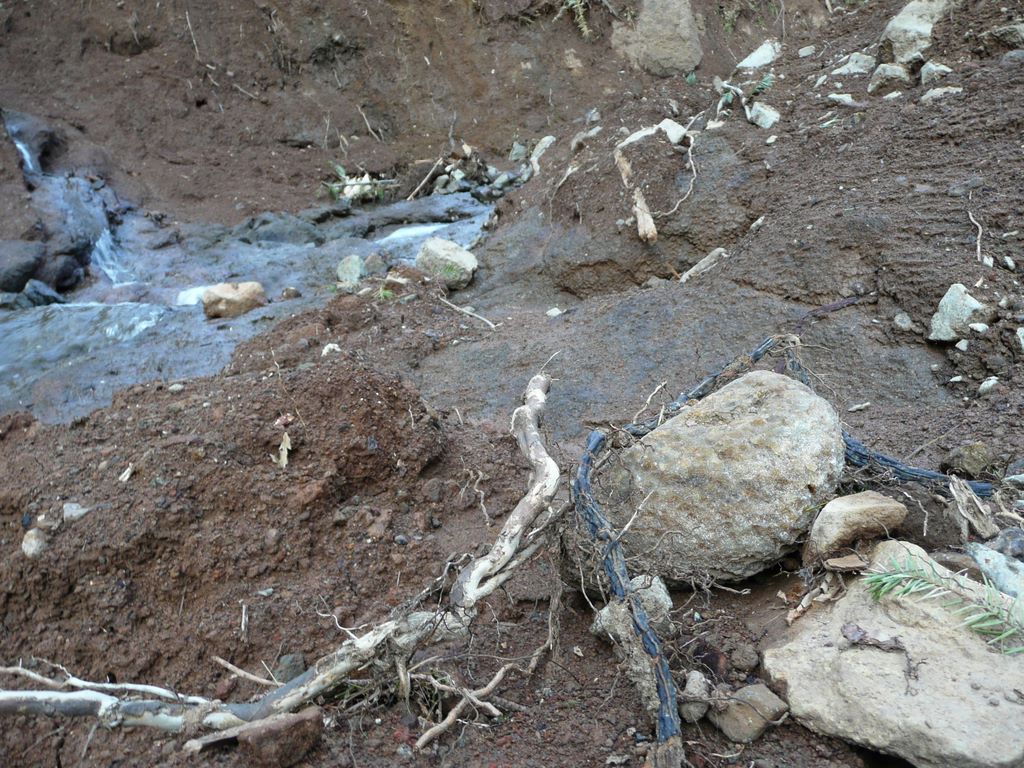
This gray agate in plain sight was inconspicuous enough that I passed by it twice without noticing it.
January 2009 Agate collecting on Lucas Creek east of Centralia (area now closed)
IMPORTANT NOTE: As of Fall 2009, Weyerhaeuser has closed Lucas Creek to all agate collecting due to excessive digging in and along the stream.
In January 2009 a landlide and mudflow swept down one of the tributaries of Lucas Creek terminating in an enormous logjam. The mudflow stripped away all the vegetation and much of the topsoil from nearly two miles of the stream valley, exposing and reworking the gravel which contains most of the agate. Numerous large agate nodules, geodes and chunks of seam agate were exposed. Rockhounds were quick to discover the treasure-trove; during the two weeks following the flood, considerably more than a ton of agate was removed from the upper branches of Lucas Creek with most of that coming from the landslide fork. Little if any of that agate was found by digging - we carried shovels to fish agates and possible agates out of deeper water and to pry partially-exposed agates out of the gravel. Photos in the creek were taken over the course of half a dozen trips during January and February 2009.
Colorful broken geode about 7" long sitting at the edge of Feeder #2 just above the road. I left it there.
January 2009 Agate collecting on Lucas Creek east of Centralia (area now closed)
IMPORTANT NOTE: As of Fall 2009, Weyerhaeuser has closed Lucas Creek to all agate collecting due to excessive digging in and along the stream.
In January 2009 a landlide and mudflow swept down one of the tributaries of Lucas Creek terminating in an enormous logjam. The mudflow stripped away all the vegetation and much of the topsoil from nearly two miles of the stream valley, exposing and reworking the gravel which contains most of the agate. Numerous large agate nodules, geodes and chunks of seam agate were exposed. Rockhounds were quick to discover the treasure-trove; during the two weeks following the flood, considerably more than a ton of agate was removed from the upper branches of Lucas Creek with most of that coming from the landslide fork. Little if any of that agate was found by digging - we carried shovels to fish agates and possible agates out of deeper water and to pry partially-exposed agates out of the gravel. Photos in the creek were taken over the course of half a dozen trips during January and February 2009.
Small section of geode with banded rind.
January 2009 Agate collecting on Lucas Creek east of Centralia (area now closed)
IMPORTANT NOTE: As of Fall 2009, Weyerhaeuser has closed Lucas Creek to all agate collecting due to excessive digging in and along the stream.
In January 2009 a landlide and mudflow swept down one of the tributaries of Lucas Creek terminating in an enormous logjam. The mudflow stripped away all the vegetation and much of the topsoil from nearly two miles of the stream valley, exposing and reworking the gravel which contains most of the agate. Numerous large agate nodules, geodes and chunks of seam agate were exposed. Rockhounds were quick to discover the treasure-trove; during the two weeks following the flood, considerably more than a ton of agate was removed from the upper branches of Lucas Creek with most of that coming from the landslide fork. Little if any of that agate was found by digging - we carried shovels to fish agates and possible agates out of deeper water and to pry partially-exposed agates out of the gravel. Photos in the creek were taken over the course of half a dozen trips during January and February 2009.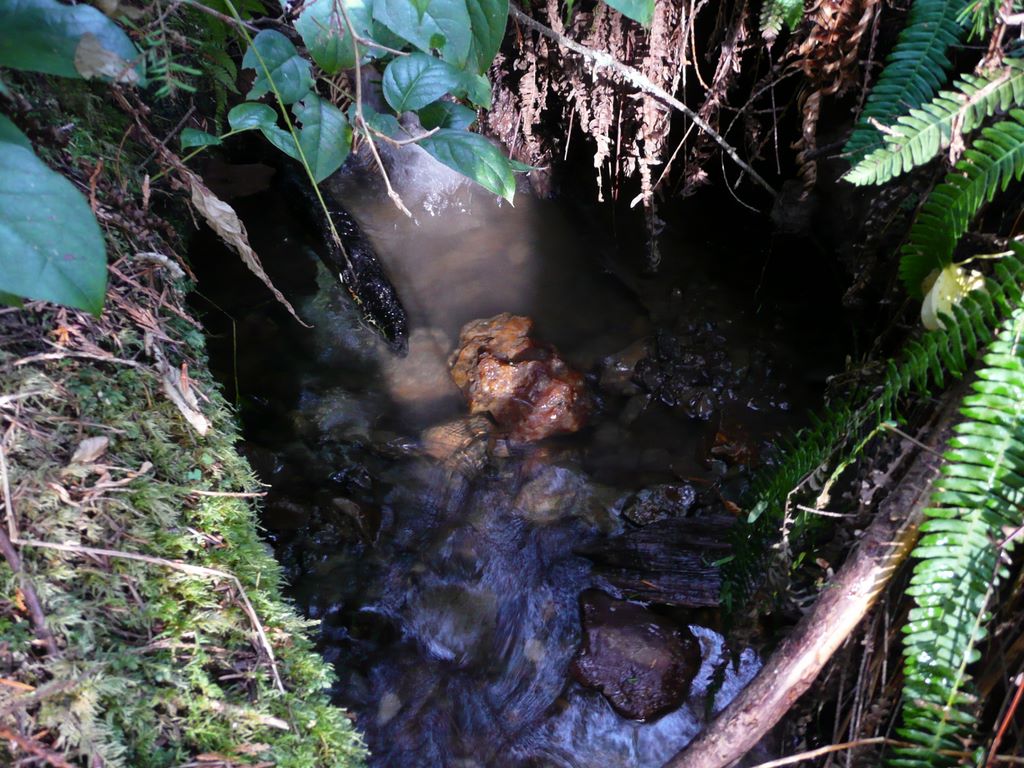
7" agate nodule in Feeder #5 in a narrow gully clogged with brush and logs. This short section of stream also produced another 7" nodule as well as a flattened 7" geode.
January 2009 Agate collecting on Lucas Creek east of Centralia (area now closed)
IMPORTANT NOTE: As of Fall 2009, Weyerhaeuser has closed Lucas Creek to all agate collecting due to excessive digging in and along the stream.
In January 2009 a landlide and mudflow swept down one of the tributaries of Lucas Creek terminating in an enormous logjam. The mudflow stripped away all the vegetation and much of the topsoil from nearly two miles of the stream valley, exposing and reworking the gravel which contains most of the agate. Numerous large agate nodules, geodes and chunks of seam agate were exposed. Rockhounds were quick to discover the treasure-trove; during the two weeks following the flood, considerably more than a ton of agate was removed from the upper branches of Lucas Creek with most of that coming from the landslide fork. Little if any of that agate was found by digging - we carried shovels to fish agates and possible agates out of deeper water and to pry partially-exposed agates out of the gravel. Photos in the creek were taken over the course of half a dozen trips during January and February 2009.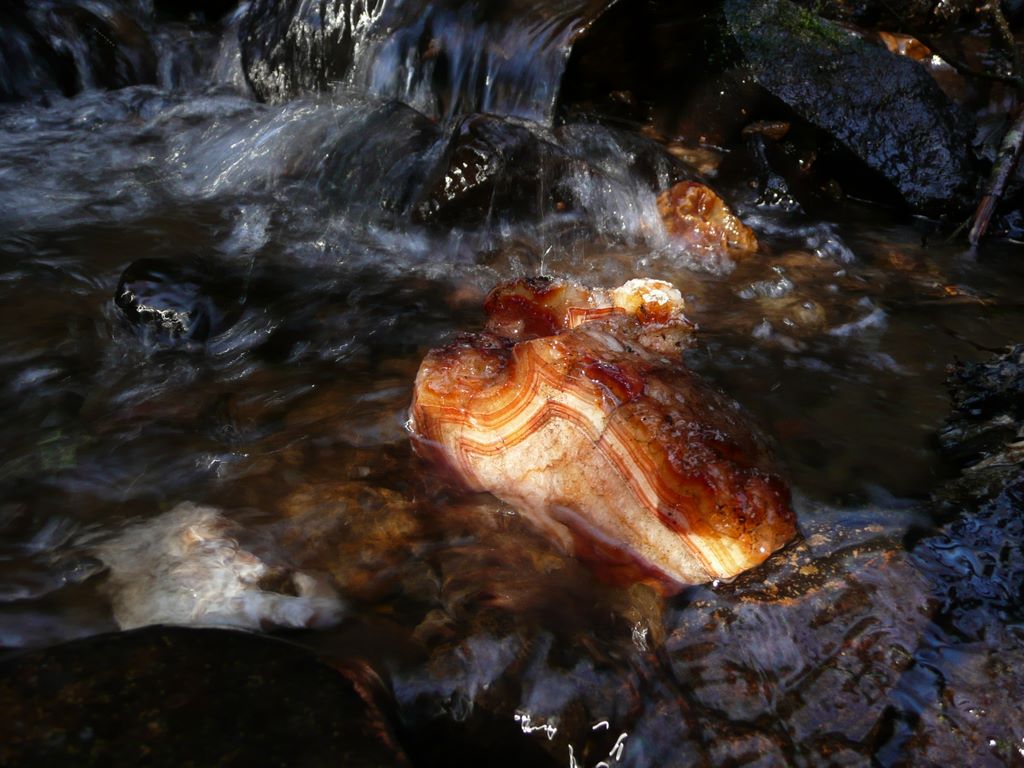
Bright banded agate illuminated by the sunshine. It was among half a dozen fist-sized agates in a ten foot section of Feeder #1 at about 1350' elevation.
January 2009 Agate collecting on Lucas Creek east of Centralia (area now closed)
IMPORTANT NOTE: As of Fall 2009, Weyerhaeuser has closed Lucas Creek to all agate collecting due to excessive digging in and along the stream.
In January 2009 a landlide and mudflow swept down one of the tributaries of Lucas Creek terminating in an enormous logjam. The mudflow stripped away all the vegetation and much of the topsoil from nearly two miles of the stream valley, exposing and reworking the gravel which contains most of the agate. Numerous large agate nodules, geodes and chunks of seam agate were exposed. Rockhounds were quick to discover the treasure-trove; during the two weeks following the flood, considerably more than a ton of agate was removed from the upper branches of Lucas Creek with most of that coming from the landslide fork. Little if any of that agate was found by digging - we carried shovels to fish agates and possible agates out of deeper water and to pry partially-exposed agates out of the gravel. Photos in the creek were taken over the course of half a dozen trips during January and February 2009.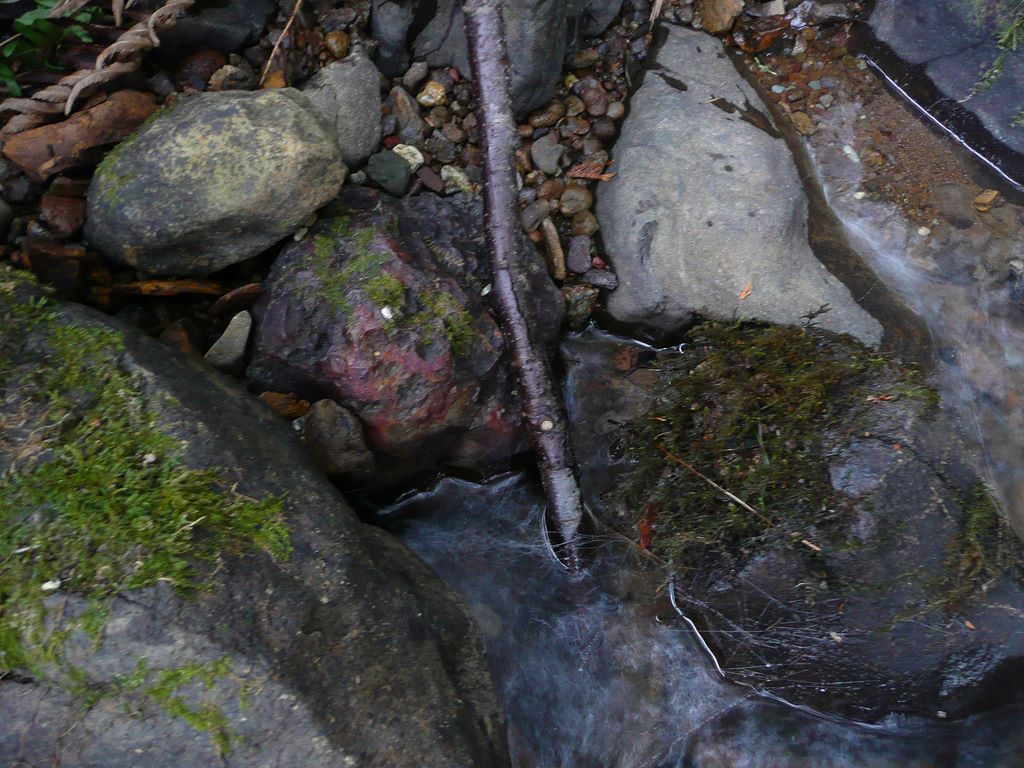
Red agate embedded in the bank of Feeder #4, same location as the 96 pound seam agate which follows. If I hadn't stepped into the creek to photograph the big seam agate, I would have missed this one.
January 2009 Agate collecting on Lucas Creek east of Centralia (area now closed)
IMPORTANT NOTE: As of Fall 2009, Weyerhaeuser has closed Lucas Creek to all agate collecting due to excessive digging in and along the stream.
In January 2009 a landlide and mudflow swept down one of the tributaries of Lucas Creek terminating in an enormous logjam. The mudflow stripped away all the vegetation and much of the topsoil from nearly two miles of the stream valley, exposing and reworking the gravel which contains most of the agate. Numerous large agate nodules, geodes and chunks of seam agate were exposed. Rockhounds were quick to discover the treasure-trove; during the two weeks following the flood, considerably more than a ton of agate was removed from the upper branches of Lucas Creek with most of that coming from the landslide fork. Little if any of that agate was found by digging - we carried shovels to fish agates and possible agates out of deeper water and to pry partially-exposed agates out of the gravel. Photos in the creek were taken over the course of half a dozen trips during January and February 2009.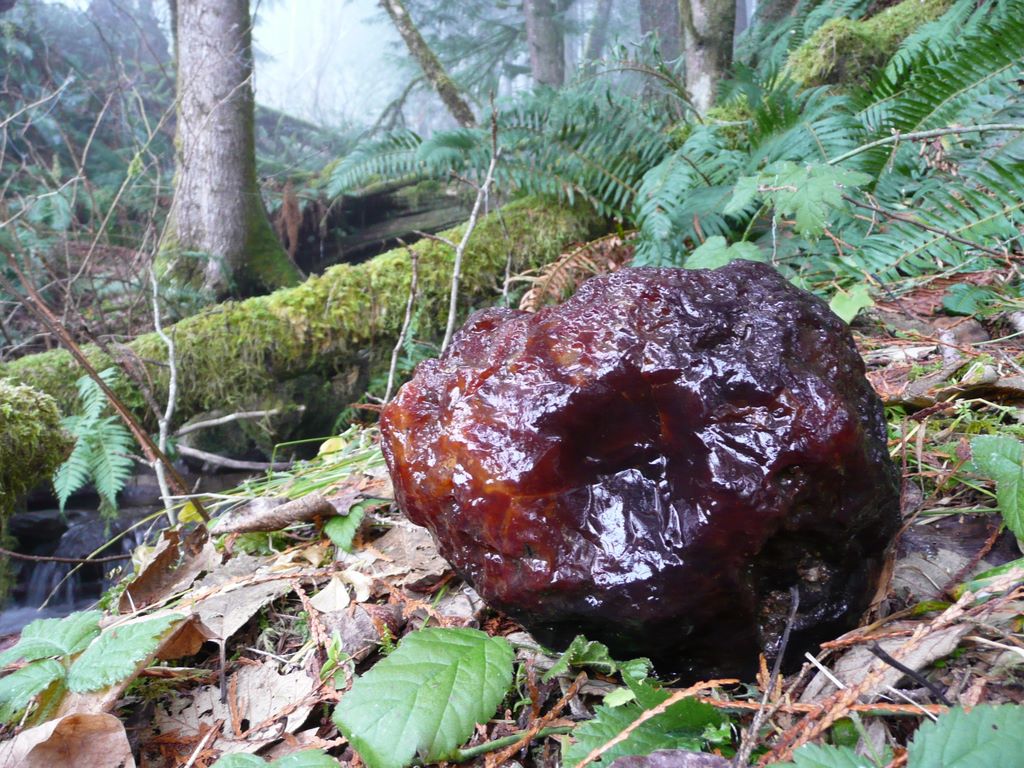
The red one turned out to be 7" across and 15 pounds, a spectacular chunk of carnelian. I'm looking forward to seeing what it's like inside.
January 2009 Agate collecting on Lucas Creek east of Centralia (area now closed)
IMPORTANT NOTE: As of Fall 2009, Weyerhaeuser has closed Lucas Creek to all agate collecting due to excessive digging in and along the stream.
In January 2009 a landlide and mudflow swept down one of the tributaries of Lucas Creek terminating in an enormous logjam. The mudflow stripped away all the vegetation and much of the topsoil from nearly two miles of the stream valley, exposing and reworking the gravel which contains most of the agate. Numerous large agate nodules, geodes and chunks of seam agate were exposed. Rockhounds were quick to discover the treasure-trove; during the two weeks following the flood, considerably more than a ton of agate was removed from the upper branches of Lucas Creek with most of that coming from the landslide fork. Little if any of that agate was found by digging - we carried shovels to fish agates and possible agates out of deeper water and to pry partially-exposed agates out of the gravel. Photos in the creek were taken over the course of half a dozen trips during January and February 2009.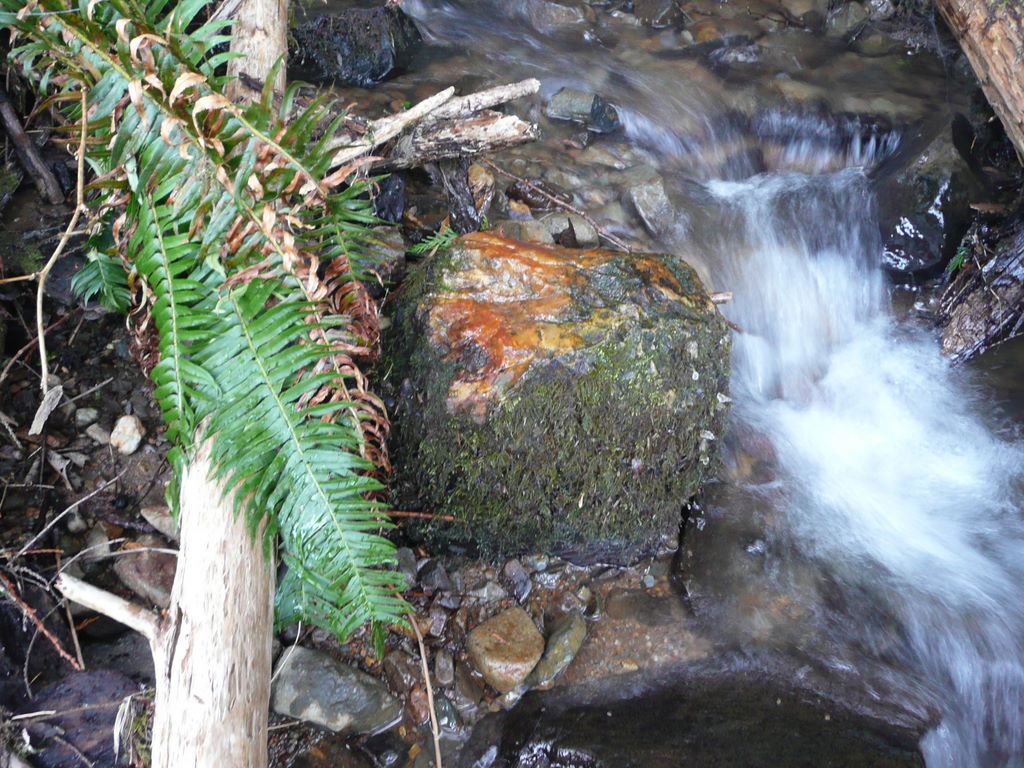
The 96 pound seam agate just above the road in Feeder #4. When Pat and I were trying to get it out I dropped it and it chopped off the tip of my little finger.
January 2009 Agate collecting on Lucas Creek east of Centralia (area now closed)
IMPORTANT NOTE: As of Fall 2009, Weyerhaeuser has closed Lucas Creek to all agate collecting due to excessive digging in and along the stream.
In January 2009 a landlide and mudflow swept down one of the tributaries of Lucas Creek terminating in an enormous logjam. The mudflow stripped away all the vegetation and much of the topsoil from nearly two miles of the stream valley, exposing and reworking the gravel which contains most of the agate. Numerous large agate nodules, geodes and chunks of seam agate were exposed. Rockhounds were quick to discover the treasure-trove; during the two weeks following the flood, considerably more than a ton of agate was removed from the upper branches of Lucas Creek with most of that coming from the landslide fork. Little if any of that agate was found by digging - we carried shovels to fish agates and possible agates out of deeper water and to pry partially-exposed agates out of the gravel. Photos in the creek were taken over the course of half a dozen trips during January and February 2009.
Pat hauling the 96 pound agate out on his modified deer-carrier.
January 2009 Agate collecting on Lucas Creek east of Centralia (area now closed)
IMPORTANT NOTE: As of Fall 2009, Weyerhaeuser has closed Lucas Creek to all agate collecting due to excessive digging in and along the stream.
In January 2009 a landlide and mudflow swept down one of the tributaries of Lucas Creek terminating in an enormous logjam. The mudflow stripped away all the vegetation and much of the topsoil from nearly two miles of the stream valley, exposing and reworking the gravel which contains most of the agate. Numerous large agate nodules, geodes and chunks of seam agate were exposed. Rockhounds were quick to discover the treasure-trove; during the two weeks following the flood, considerably more than a ton of agate was removed from the upper branches of Lucas Creek with most of that coming from the landslide fork. Little if any of that agate was found by digging - we carried shovels to fish agates and possible agates out of deeper water and to pry partially-exposed agates out of the gravel. Photos in the creek were taken over the course of half a dozen trips during January and February 2009.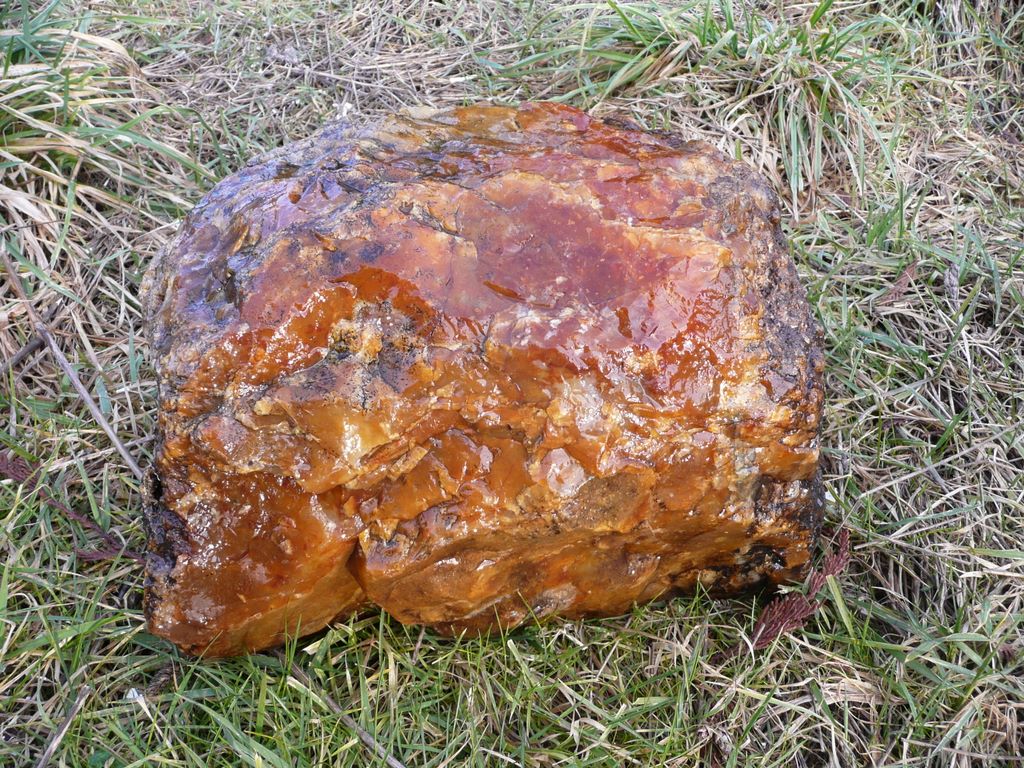
The 96 pound agate after cleaning with pressure washer and Barkeeper's Friend.
January 2009 Agate collecting on Lucas Creek east of Centralia (area now closed)
IMPORTANT NOTE: As of Fall 2009, Weyerhaeuser has closed Lucas Creek to all agate collecting due to excessive digging in and along the stream.
In January 2009 a landlide and mudflow swept down one of the tributaries of Lucas Creek terminating in an enormous logjam. The mudflow stripped away all the vegetation and much of the topsoil from nearly two miles of the stream valley, exposing and reworking the gravel which contains most of the agate. Numerous large agate nodules, geodes and chunks of seam agate were exposed. Rockhounds were quick to discover the treasure-trove; during the two weeks following the flood, considerably more than a ton of agate was removed from the upper branches of Lucas Creek with most of that coming from the landslide fork. Little if any of that agate was found by digging - we carried shovels to fish agates and possible agates out of deeper water and to pry partially-exposed agates out of the gravel. Photos in the creek were taken over the course of half a dozen trips during January and February 2009.
Another view of the 96 pound agate after cleaning.
January 2009 Agate collecting on Lucas Creek east of Centralia (area now closed)
IMPORTANT NOTE: As of Fall 2009, Weyerhaeuser has closed Lucas Creek to all agate collecting due to excessive digging in and along the stream.
In January 2009 a landlide and mudflow swept down one of the tributaries of Lucas Creek terminating in an enormous logjam. The mudflow stripped away all the vegetation and much of the topsoil from nearly two miles of the stream valley, exposing and reworking the gravel which contains most of the agate. Numerous large agate nodules, geodes and chunks of seam agate were exposed. Rockhounds were quick to discover the treasure-trove; during the two weeks following the flood, considerably more than a ton of agate was removed from the upper branches of Lucas Creek with most of that coming from the landslide fork. Little if any of that agate was found by digging - we carried shovels to fish agates and possible agates out of deeper water and to pry partially-exposed agates out of the gravel. Photos in the creek were taken over the course of half a dozen trips during January and February 2009.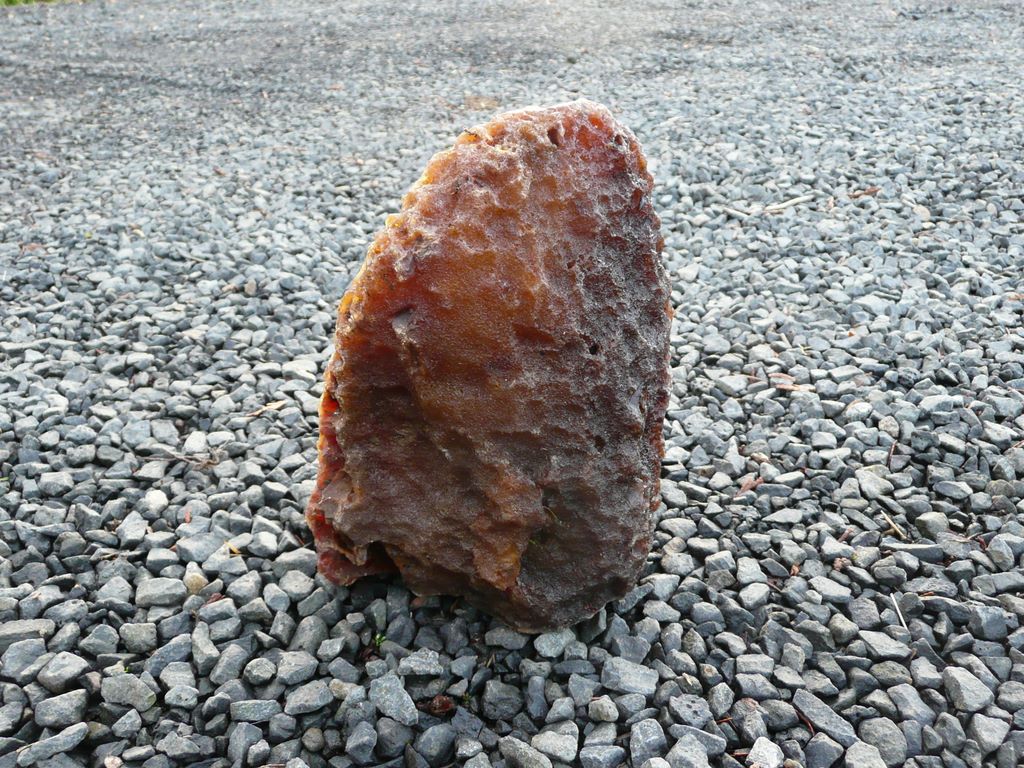
7" agate nodule from Feeder #5. I gave this one to Pat in exchange for using his deer carrier to haul out my 70 pound seam agate, and because he liked it.
January 2009 Agate collecting on Lucas Creek east of Centralia (area now closed)
IMPORTANT NOTE: As of Fall 2009, Weyerhaeuser has closed Lucas Creek to all agate collecting due to excessive digging in and along the stream.
In January 2009 a landlide and mudflow swept down one of the tributaries of Lucas Creek terminating in an enormous logjam. The mudflow stripped away all the vegetation and much of the topsoil from nearly two miles of the stream valley, exposing and reworking the gravel which contains most of the agate. Numerous large agate nodules, geodes and chunks of seam agate were exposed. Rockhounds were quick to discover the treasure-trove; during the two weeks following the flood, considerably more than a ton of agate was removed from the upper branches of Lucas Creek with most of that coming from the landslide fork. Little if any of that agate was found by digging - we carried shovels to fish agates and possible agates out of deeper water and to pry partially-exposed agates out of the gravel. Photos in the creek were taken over the course of half a dozen trips during January and February 2009.
5" orange nodule, from Feeder #2 I think.
January 2009 Agate collecting on Lucas Creek east of Centralia (area now closed)
IMPORTANT NOTE: As of Fall 2009, Weyerhaeuser has closed Lucas Creek to all agate collecting due to excessive digging in and along the stream.
In January 2009 a landlide and mudflow swept down one of the tributaries of Lucas Creek terminating in an enormous logjam. The mudflow stripped away all the vegetation and much of the topsoil from nearly two miles of the stream valley, exposing and reworking the gravel which contains most of the agate. Numerous large agate nodules, geodes and chunks of seam agate were exposed. Rockhounds were quick to discover the treasure-trove; during the two weeks following the flood, considerably more than a ton of agate was removed from the upper branches of Lucas Creek with most of that coming from the landslide fork. Little if any of that agate was found by digging - we carried shovels to fish agates and possible agates out of deeper water and to pry partially-exposed agates out of the gravel. Photos in the creek were taken over the course of half a dozen trips during January and February 2009.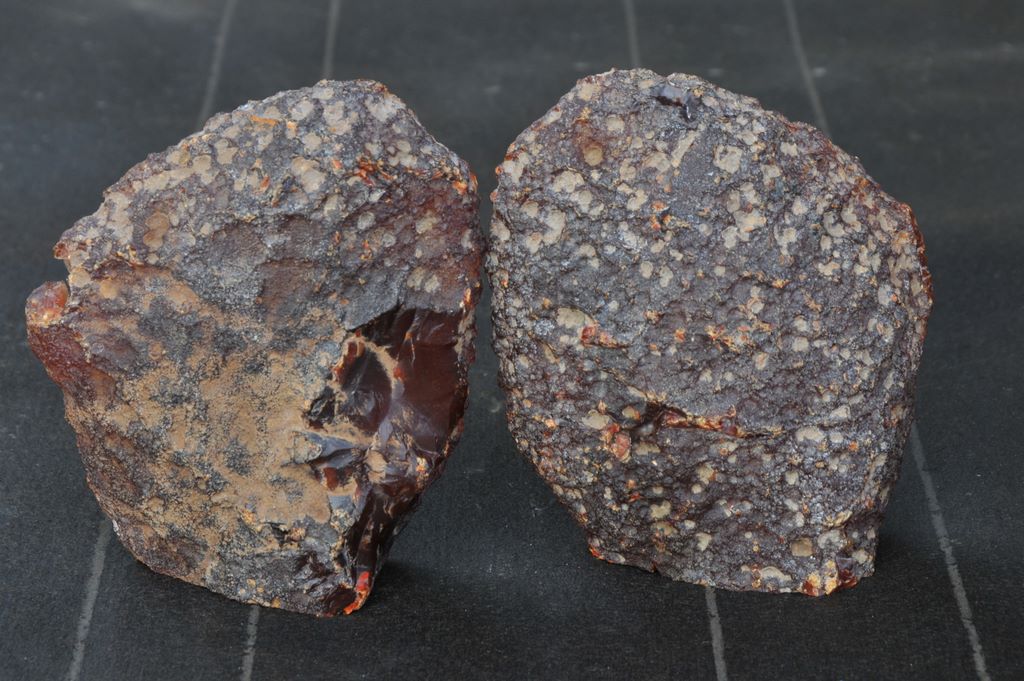
7", 6 pound dark red agate nodule from the main stem just below where the landslide fork comes in. This was the first big agate I found on our first day up Lucas Creek after the landslide.
January 2009 Agate collecting on Lucas Creek east of Centralia (area now closed)
IMPORTANT NOTE: As of Fall 2009, Weyerhaeuser has closed Lucas Creek to all agate collecting due to excessive digging in and along the stream.
In January 2009 a landlide and mudflow swept down one of the tributaries of Lucas Creek terminating in an enormous logjam. The mudflow stripped away all the vegetation and much of the topsoil from nearly two miles of the stream valley, exposing and reworking the gravel which contains most of the agate. Numerous large agate nodules, geodes and chunks of seam agate were exposed. Rockhounds were quick to discover the treasure-trove; during the two weeks following the flood, considerably more than a ton of agate was removed from the upper branches of Lucas Creek with most of that coming from the landslide fork. Little if any of that agate was found by digging - we carried shovels to fish agates and possible agates out of deeper water and to pry partially-exposed agates out of the gravel. Photos in the creek were taken over the course of half a dozen trips during January and February 2009.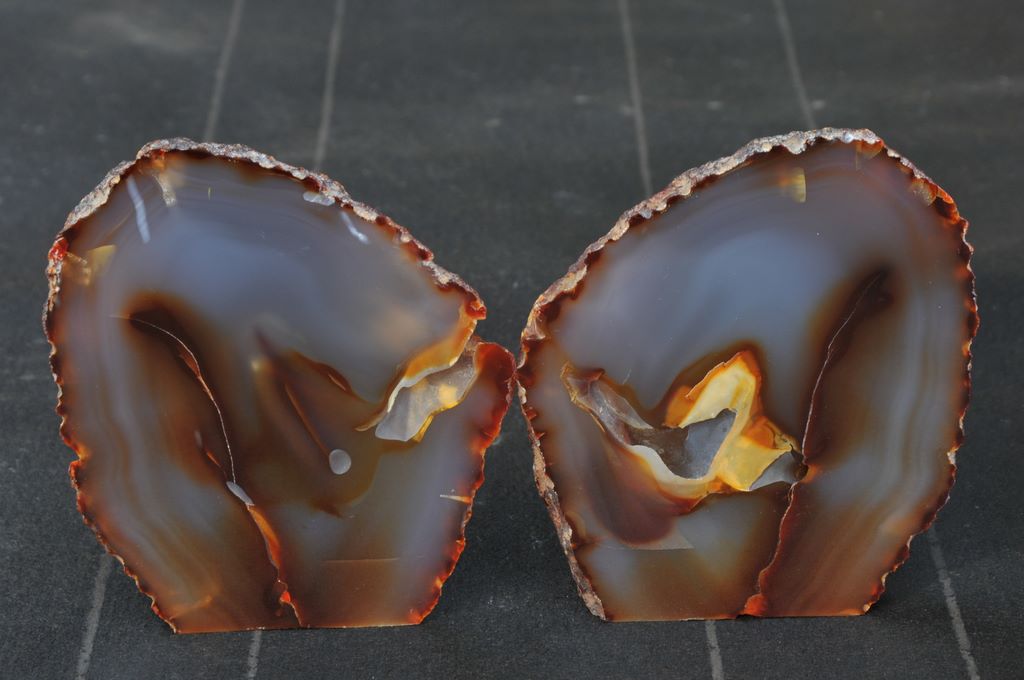
Finding this agate was an amazing way to start an amazing day, our first trip up Lucas Creek after the landslide and mudflow scoured out the second tributary.!
January 2009 Agate collecting on Lucas Creek east of Centralia (area now closed)
IMPORTANT NOTE: As of Fall 2009, Weyerhaeuser has closed Lucas Creek to all agate collecting due to excessive digging in and along the stream.
In January 2009 a landlide and mudflow swept down one of the tributaries of Lucas Creek terminating in an enormous logjam. The mudflow stripped away all the vegetation and much of the topsoil from nearly two miles of the stream valley, exposing and reworking the gravel which contains most of the agate. Numerous large agate nodules, geodes and chunks of seam agate were exposed. Rockhounds were quick to discover the treasure-trove; during the two weeks following the flood, considerably more than a ton of agate was removed from the upper branches of Lucas Creek with most of that coming from the landslide fork. Little if any of that agate was found by digging - we carried shovels to fish agates and possible agates out of deeper water and to pry partially-exposed agates out of the gravel. Photos in the creek were taken over the course of half a dozen trips during January and February 2009.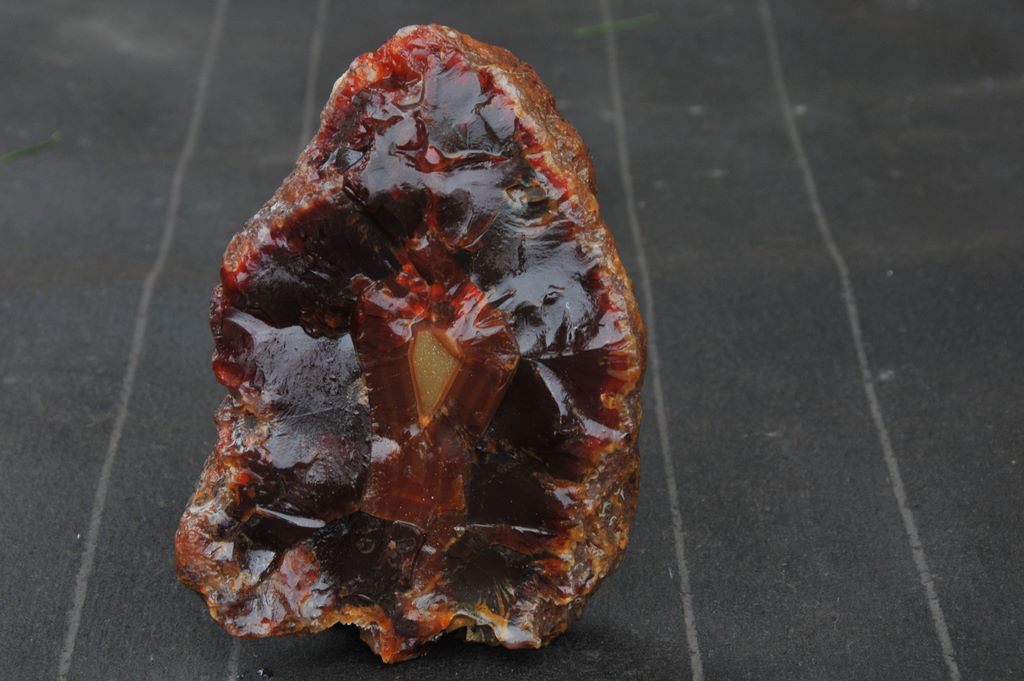
Dark red carnelian geode, 8" tall, from the rich gravel bar below our lunch spot on our first day up the landslide creek.
January 2009 Agate collecting on Lucas Creek east of Centralia (area now closed)
IMPORTANT NOTE: As of Fall 2009, Weyerhaeuser has closed Lucas Creek to all agate collecting due to excessive digging in and along the stream.
In January 2009 a landlide and mudflow swept down one of the tributaries of Lucas Creek terminating in an enormous logjam. The mudflow stripped away all the vegetation and much of the topsoil from nearly two miles of the stream valley, exposing and reworking the gravel which contains most of the agate. Numerous large agate nodules, geodes and chunks of seam agate were exposed. Rockhounds were quick to discover the treasure-trove; during the two weeks following the flood, considerably more than a ton of agate was removed from the upper branches of Lucas Creek with most of that coming from the landslide fork. Little if any of that agate was found by digging - we carried shovels to fish agates and possible agates out of deeper water and to pry partially-exposed agates out of the gravel. Photos in the creek were taken over the course of half a dozen trips during January and February 2009.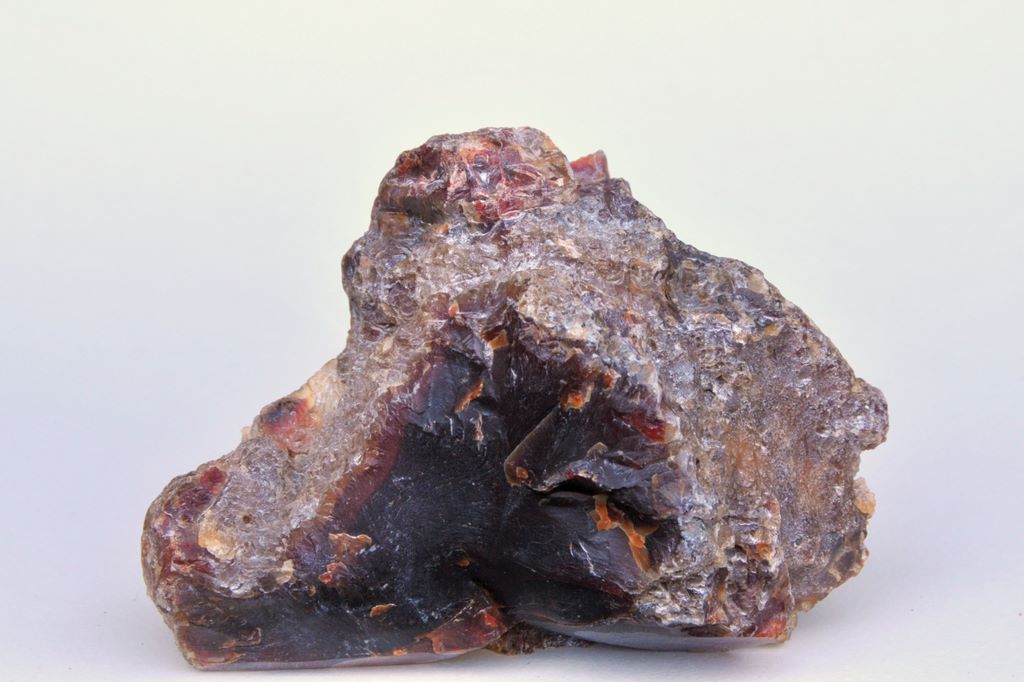
Base which broke off the piece in the previous photo.
January 2009 Agate collecting on Lucas Creek east of Centralia (area now closed)
IMPORTANT NOTE: As of Fall 2009, Weyerhaeuser has closed Lucas Creek to all agate collecting due to excessive digging in and along the stream.
In January 2009 a landlide and mudflow swept down one of the tributaries of Lucas Creek terminating in an enormous logjam. The mudflow stripped away all the vegetation and much of the topsoil from nearly two miles of the stream valley, exposing and reworking the gravel which contains most of the agate. Numerous large agate nodules, geodes and chunks of seam agate were exposed. Rockhounds were quick to discover the treasure-trove; during the two weeks following the flood, considerably more than a ton of agate was removed from the upper branches of Lucas Creek with most of that coming from the landslide fork. Little if any of that agate was found by digging - we carried shovels to fish agates and possible agates out of deeper water and to pry partially-exposed agates out of the gravel. Photos in the creek were taken over the course of half a dozen trips during January and February 2009.
Flip side of the piece in the previous photo, cut and polished. About 5" wide.
January 2009 Agate collecting on Lucas Creek east of Centralia (area now closed)
IMPORTANT NOTE: As of Fall 2009, Weyerhaeuser has closed Lucas Creek to all agate collecting due to excessive digging in and along the stream.
In January 2009 a landlide and mudflow swept down one of the tributaries of Lucas Creek terminating in an enormous logjam. The mudflow stripped away all the vegetation and much of the topsoil from nearly two miles of the stream valley, exposing and reworking the gravel which contains most of the agate. Numerous large agate nodules, geodes and chunks of seam agate were exposed. Rockhounds were quick to discover the treasure-trove; during the two weeks following the flood, considerably more than a ton of agate was removed from the upper branches of Lucas Creek with most of that coming from the landslide fork. Little if any of that agate was found by digging - we carried shovels to fish agates and possible agates out of deeper water and to pry partially-exposed agates out of the gravel. Photos in the creek were taken over the course of half a dozen trips during January and February 2009.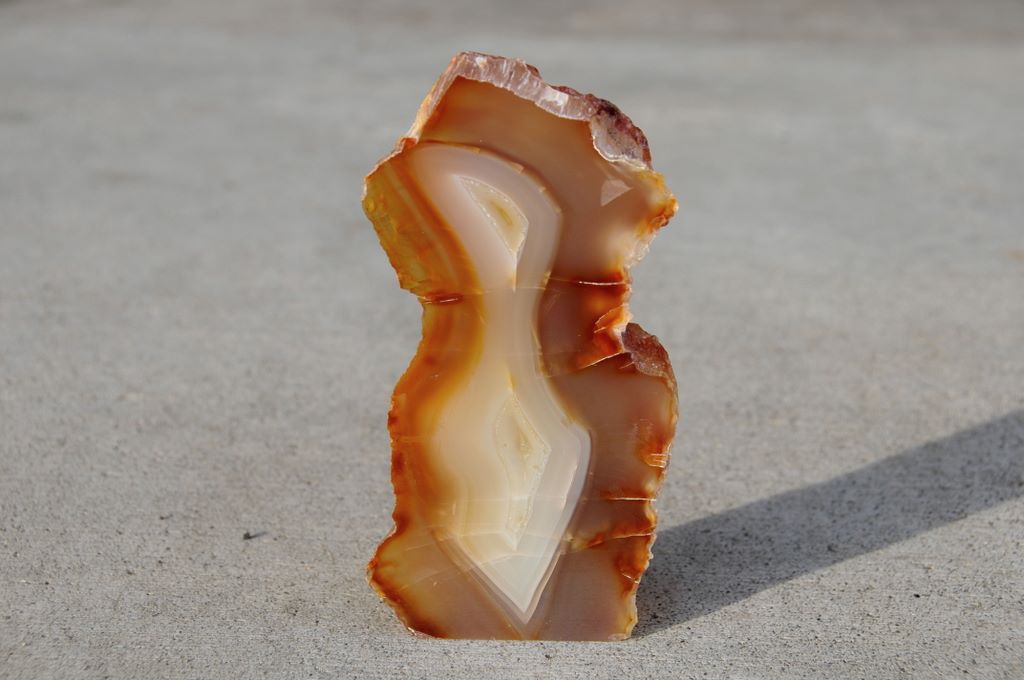
The end sliced off of one of Daniel's agate nodules from the first day up the creek.
January 2009 Agate collecting on Lucas Creek east of Centralia (area now closed)
IMPORTANT NOTE: As of Fall 2009, Weyerhaeuser has closed Lucas Creek to all agate collecting due to excessive digging in and along the stream.
In January 2009 a landlide and mudflow swept down one of the tributaries of Lucas Creek terminating in an enormous logjam. The mudflow stripped away all the vegetation and much of the topsoil from nearly two miles of the stream valley, exposing and reworking the gravel which contains most of the agate. Numerous large agate nodules, geodes and chunks of seam agate were exposed. Rockhounds were quick to discover the treasure-trove; during the two weeks following the flood, considerably more than a ton of agate was removed from the upper branches of Lucas Creek with most of that coming from the landslide fork. Little if any of that agate was found by digging - we carried shovels to fish agates and possible agates out of deeper water and to pry partially-exposed agates out of the gravel. Photos in the creek were taken over the course of half a dozen trips during January and February 2009.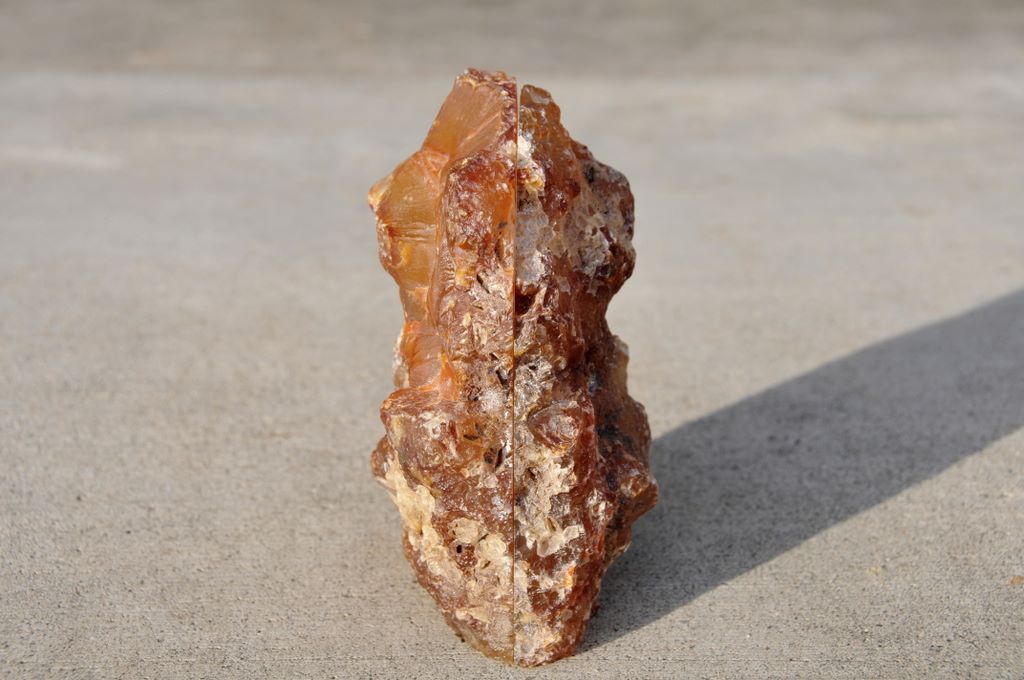
The other side of Daniel's agate nodule.
January 2009 Agate collecting on Lucas Creek east of Centralia (area now closed)
IMPORTANT NOTE: As of Fall 2009, Weyerhaeuser has closed Lucas Creek to all agate collecting due to excessive digging in and along the stream.
In January 2009 a landlide and mudflow swept down one of the tributaries of Lucas Creek terminating in an enormous logjam. The mudflow stripped away all the vegetation and much of the topsoil from nearly two miles of the stream valley, exposing and reworking the gravel which contains most of the agate. Numerous large agate nodules, geodes and chunks of seam agate were exposed. Rockhounds were quick to discover the treasure-trove; during the two weeks following the flood, considerably more than a ton of agate was removed from the upper branches of Lucas Creek with most of that coming from the landslide fork. Little if any of that agate was found by digging - we carried shovels to fish agates and possible agates out of deeper water and to pry partially-exposed agates out of the gravel. Photos in the creek were taken over the course of half a dozen trips during January and February 2009.
The interior of Daniel's agate nodule.
January 2009 Agate collecting on Lucas Creek east of Centralia (area now closed)
IMPORTANT NOTE: As of Fall 2009, Weyerhaeuser has closed Lucas Creek to all agate collecting due to excessive digging in and along the stream.
In January 2009 a landlide and mudflow swept down one of the tributaries of Lucas Creek terminating in an enormous logjam. The mudflow stripped away all the vegetation and much of the topsoil from nearly two miles of the stream valley, exposing and reworking the gravel which contains most of the agate. Numerous large agate nodules, geodes and chunks of seam agate were exposed. Rockhounds were quick to discover the treasure-trove; during the two weeks following the flood, considerably more than a ton of agate was removed from the upper branches of Lucas Creek with most of that coming from the landslide fork. Little if any of that agate was found by digging - we carried shovels to fish agates and possible agates out of deeper water and to pry partially-exposed agates out of the gravel. Photos in the creek were taken over the course of half a dozen trips during January and February 2009.
This is the same agate nodule pictured with the spade.
January 2009 Agate collecting on Lucas Creek east of Centralia (area now closed)
IMPORTANT NOTE: As of Fall 2009, Weyerhaeuser has closed Lucas Creek to all agate collecting due to excessive digging in and along the stream.
In January 2009 a landlide and mudflow swept down one of the tributaries of Lucas Creek terminating in an enormous logjam. The mudflow stripped away all the vegetation and much of the topsoil from nearly two miles of the stream valley, exposing and reworking the gravel which contains most of the agate. Numerous large agate nodules, geodes and chunks of seam agate were exposed. Rockhounds were quick to discover the treasure-trove; during the two weeks following the flood, considerably more than a ton of agate was removed from the upper branches of Lucas Creek with most of that coming from the landslide fork. Little if any of that agate was found by digging - we carried shovels to fish agates and possible agates out of deeper water and to pry partially-exposed agates out of the gravel. Photos in the creek were taken over the course of half a dozen trips during January and February 2009.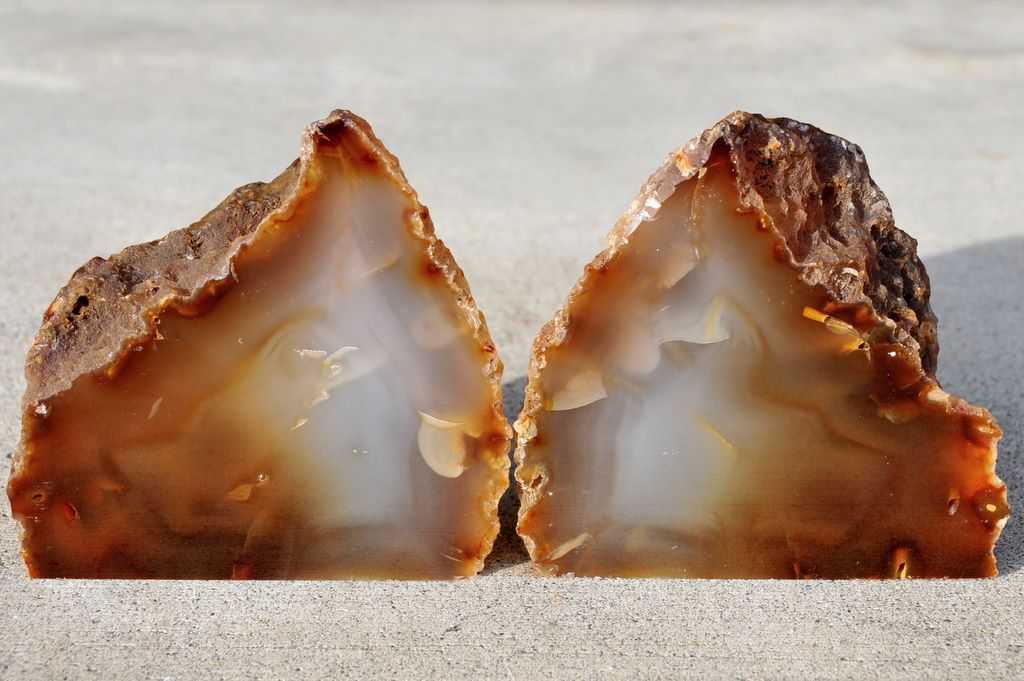
Interior of the 4" agate nodule pictured with the spade.
January 2009 Agate collecting on Lucas Creek east of Centralia (area now closed)
IMPORTANT NOTE: As of Fall 2009, Weyerhaeuser has closed Lucas Creek to all agate collecting due to excessive digging in and along the stream.
In January 2009 a landlide and mudflow swept down one of the tributaries of Lucas Creek terminating in an enormous logjam. The mudflow stripped away all the vegetation and much of the topsoil from nearly two miles of the stream valley, exposing and reworking the gravel which contains most of the agate. Numerous large agate nodules, geodes and chunks of seam agate were exposed. Rockhounds were quick to discover the treasure-trove; during the two weeks following the flood, considerably more than a ton of agate was removed from the upper branches of Lucas Creek with most of that coming from the landslide fork. Little if any of that agate was found by digging - we carried shovels to fish agates and possible agates out of deeper water and to pry partially-exposed agates out of the gravel. Photos in the creek were taken over the course of half a dozen trips during January and February 2009.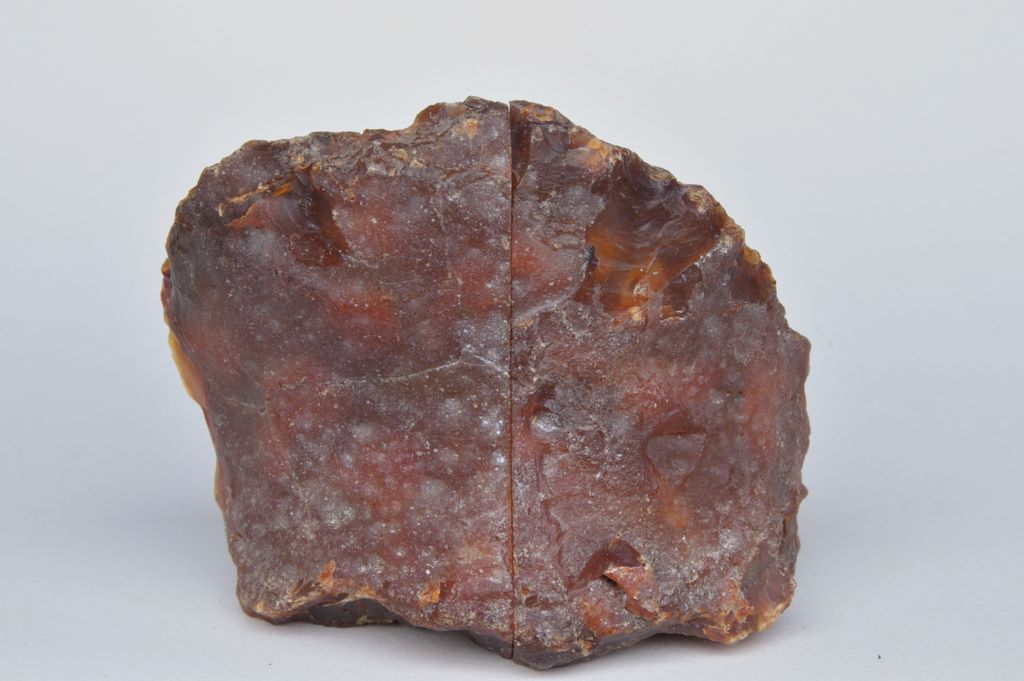
Back side of the 5" orange and yellow geode found in the stream.
January 2009 Agate collecting on Lucas Creek east of Centralia (area now closed)
IMPORTANT NOTE: As of Fall 2009, Weyerhaeuser has closed Lucas Creek to all agate collecting due to excessive digging in and along the stream.
In January 2009 a landlide and mudflow swept down one of the tributaries of Lucas Creek terminating in an enormous logjam. The mudflow stripped away all the vegetation and much of the topsoil from nearly two miles of the stream valley, exposing and reworking the gravel which contains most of the agate. Numerous large agate nodules, geodes and chunks of seam agate were exposed. Rockhounds were quick to discover the treasure-trove; during the two weeks following the flood, considerably more than a ton of agate was removed from the upper branches of Lucas Creek with most of that coming from the landslide fork. Little if any of that agate was found by digging - we carried shovels to fish agates and possible agates out of deeper water and to pry partially-exposed agates out of the gravel. Photos in the creek were taken over the course of half a dozen trips during January and February 2009.
Interior of the 5" orange and yellow geode found in the stream.
January 2009 Agate collecting on Lucas Creek east of Centralia (area now closed)
IMPORTANT NOTE: As of Fall 2009, Weyerhaeuser has closed Lucas Creek to all agate collecting due to excessive digging in and along the stream.
In January 2009 a landlide and mudflow swept down one of the tributaries of Lucas Creek terminating in an enormous logjam. The mudflow stripped away all the vegetation and much of the topsoil from nearly two miles of the stream valley, exposing and reworking the gravel which contains most of the agate. Numerous large agate nodules, geodes and chunks of seam agate were exposed. Rockhounds were quick to discover the treasure-trove; during the two weeks following the flood, considerably more than a ton of agate was removed from the upper branches of Lucas Creek with most of that coming from the landslide fork. Little if any of that agate was found by digging - we carried shovels to fish agates and possible agates out of deeper water and to pry partially-exposed agates out of the gravel. Photos in the creek were taken over the course of half a dozen trips during January and February 2009.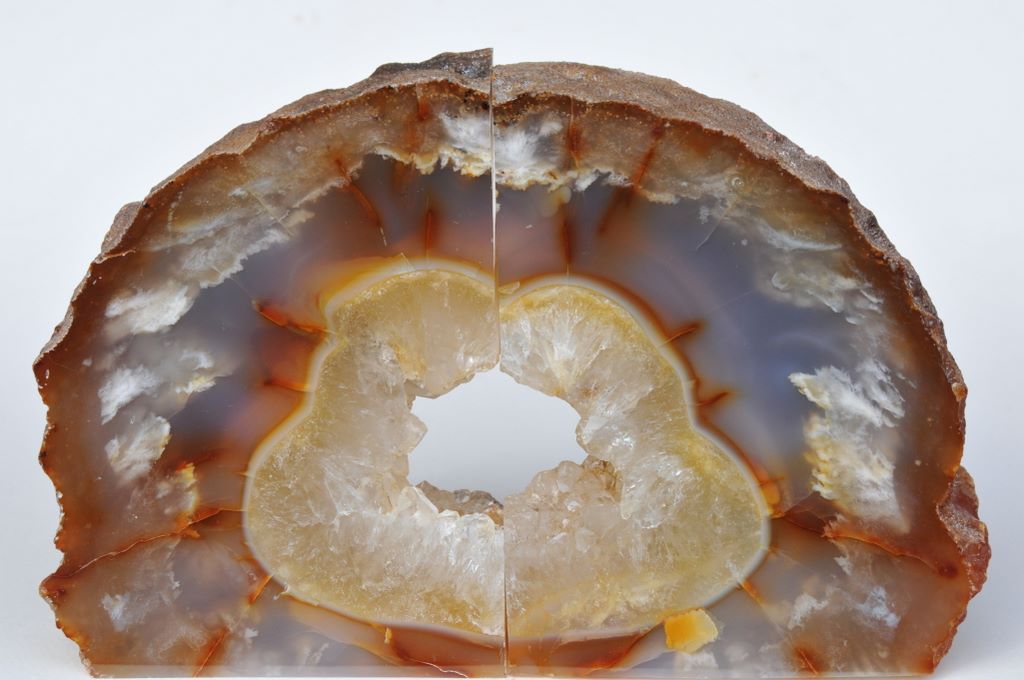
Round bookends 6" tall cut from large piece of geode found on our first day up the landslide fork. 7" tall.
January 2009 Agate collecting on Lucas Creek east of Centralia (area now closed)
IMPORTANT NOTE: As of Fall 2009, Weyerhaeuser has closed Lucas Creek to all agate collecting due to excessive digging in and along the stream.
In January 2009 a landlide and mudflow swept down one of the tributaries of Lucas Creek terminating in an enormous logjam. The mudflow stripped away all the vegetation and much of the topsoil from nearly two miles of the stream valley, exposing and reworking the gravel which contains most of the agate. Numerous large agate nodules, geodes and chunks of seam agate were exposed. Rockhounds were quick to discover the treasure-trove; during the two weeks following the flood, considerably more than a ton of agate was removed from the upper branches of Lucas Creek with most of that coming from the landslide fork. Little if any of that agate was found by digging - we carried shovels to fish agates and possible agates out of deeper water and to pry partially-exposed agates out of the gravel. Photos in the creek were taken over the course of half a dozen trips during January and February 2009.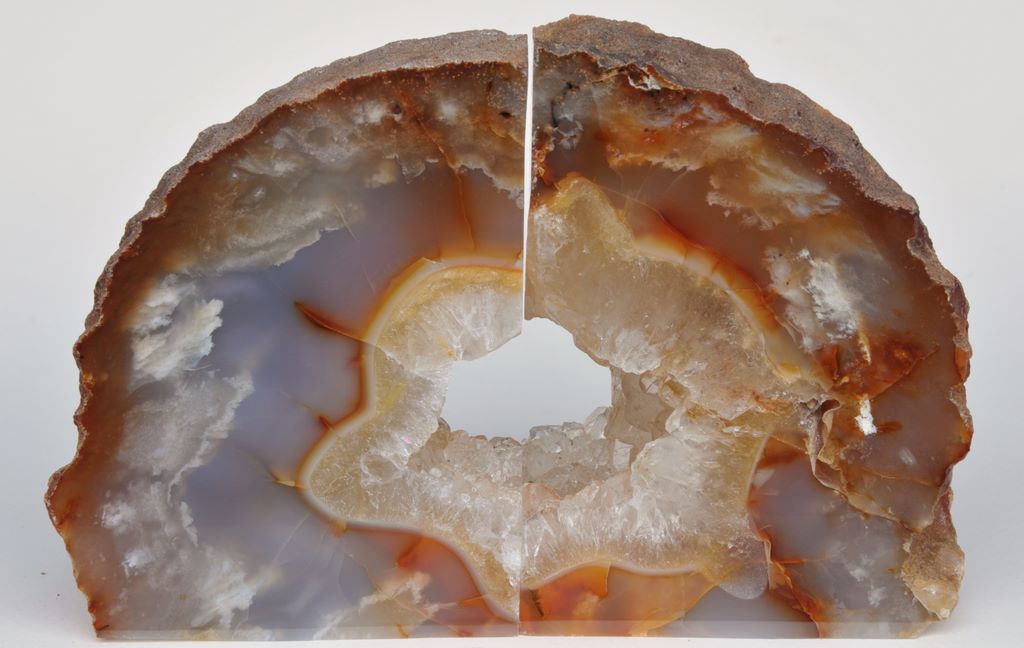
Backside of the round bookends in the previous photo.
January 2009 Agate collecting on Lucas Creek east of Centralia (area now closed)
IMPORTANT NOTE: As of Fall 2009, Weyerhaeuser has closed Lucas Creek to all agate collecting due to excessive digging in and along the stream.
In January 2009 a landlide and mudflow swept down one of the tributaries of Lucas Creek terminating in an enormous logjam. The mudflow stripped away all the vegetation and much of the topsoil from nearly two miles of the stream valley, exposing and reworking the gravel which contains most of the agate. Numerous large agate nodules, geodes and chunks of seam agate were exposed. Rockhounds were quick to discover the treasure-trove; during the two weeks following the flood, considerably more than a ton of agate was removed from the upper branches of Lucas Creek with most of that coming from the landslide fork. Little if any of that agate was found by digging - we carried shovels to fish agates and possible agates out of deeper water and to pry partially-exposed agates out of the gravel. Photos in the creek were taken over the course of half a dozen trips during January and February 2009.
Standup piece 5" tall cut from the same geode as the triangular bookends in the next three images.
January 2009 Agate collecting on Lucas Creek east of Centralia (area now closed)
IMPORTANT NOTE: As of Fall 2009, Weyerhaeuser has closed Lucas Creek to all agate collecting due to excessive digging in and along the stream.
In January 2009 a landlide and mudflow swept down one of the tributaries of Lucas Creek terminating in an enormous logjam. The mudflow stripped away all the vegetation and much of the topsoil from nearly two miles of the stream valley, exposing and reworking the gravel which contains most of the agate. Numerous large agate nodules, geodes and chunks of seam agate were exposed. Rockhounds were quick to discover the treasure-trove; during the two weeks following the flood, considerably more than a ton of agate was removed from the upper branches of Lucas Creek with most of that coming from the landslide fork. Little if any of that agate was found by digging - we carried shovels to fish agates and possible agates out of deeper water and to pry partially-exposed agates out of the gravel. Photos in the creek were taken over the course of half a dozen trips during January and February 2009.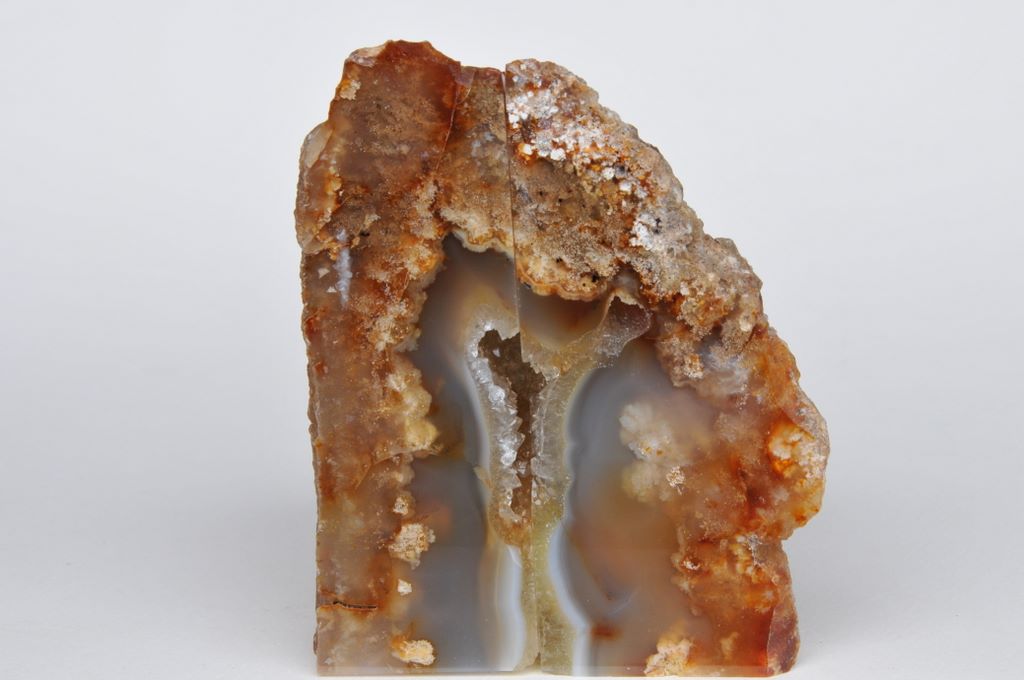
Triangular bookends, end view. 5 1/2" tall.
January 2009 Agate collecting on Lucas Creek east of Centralia (area now closed)
IMPORTANT NOTE: As of Fall 2009, Weyerhaeuser has closed Lucas Creek to all agate collecting due to excessive digging in and along the stream.
In January 2009 a landlide and mudflow swept down one of the tributaries of Lucas Creek terminating in an enormous logjam. The mudflow stripped away all the vegetation and much of the topsoil from nearly two miles of the stream valley, exposing and reworking the gravel which contains most of the agate. Numerous large agate nodules, geodes and chunks of seam agate were exposed. Rockhounds were quick to discover the treasure-trove; during the two weeks following the flood, considerably more than a ton of agate was removed from the upper branches of Lucas Creek with most of that coming from the landslide fork. Little if any of that agate was found by digging - we carried shovels to fish agates and possible agates out of deeper water and to pry partially-exposed agates out of the gravel. Photos in the creek were taken over the course of half a dozen trips during January and February 2009.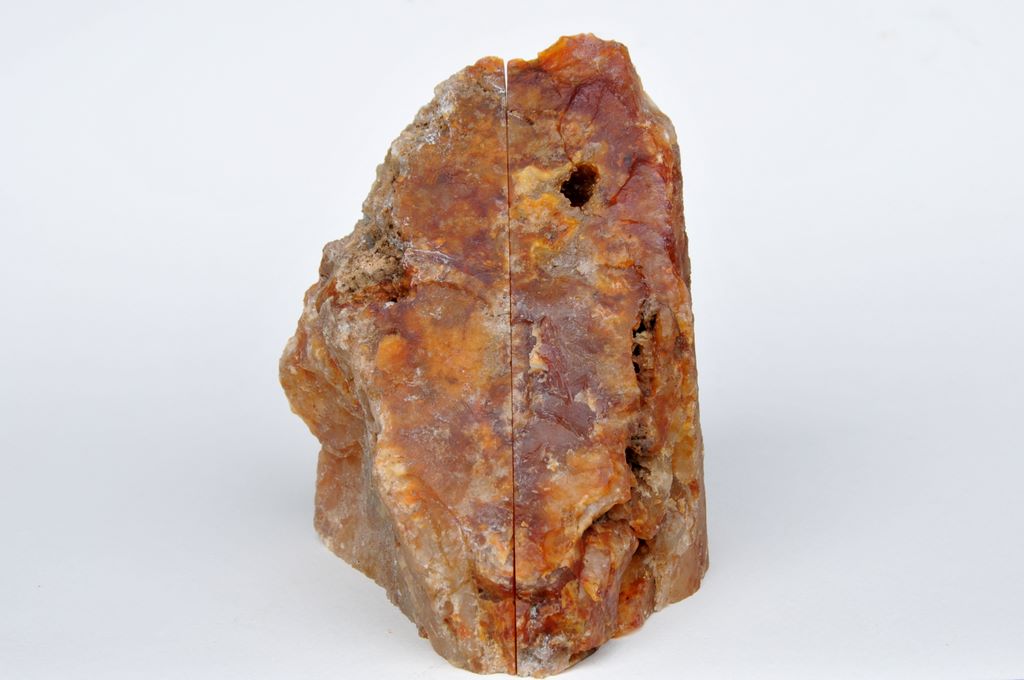
Triangular bookends, back view.
January 2009 Agate collecting on Lucas Creek east of Centralia (area now closed)
IMPORTANT NOTE: As of Fall 2009, Weyerhaeuser has closed Lucas Creek to all agate collecting due to excessive digging in and along the stream.
In January 2009 a landlide and mudflow swept down one of the tributaries of Lucas Creek terminating in an enormous logjam. The mudflow stripped away all the vegetation and much of the topsoil from nearly two miles of the stream valley, exposing and reworking the gravel which contains most of the agate. Numerous large agate nodules, geodes and chunks of seam agate were exposed. Rockhounds were quick to discover the treasure-trove; during the two weeks following the flood, considerably more than a ton of agate was removed from the upper branches of Lucas Creek with most of that coming from the landslide fork. Little if any of that agate was found by digging - we carried shovels to fish agates and possible agates out of deeper water and to pry partially-exposed agates out of the gravel. Photos in the creek were taken over the course of half a dozen trips during January and February 2009.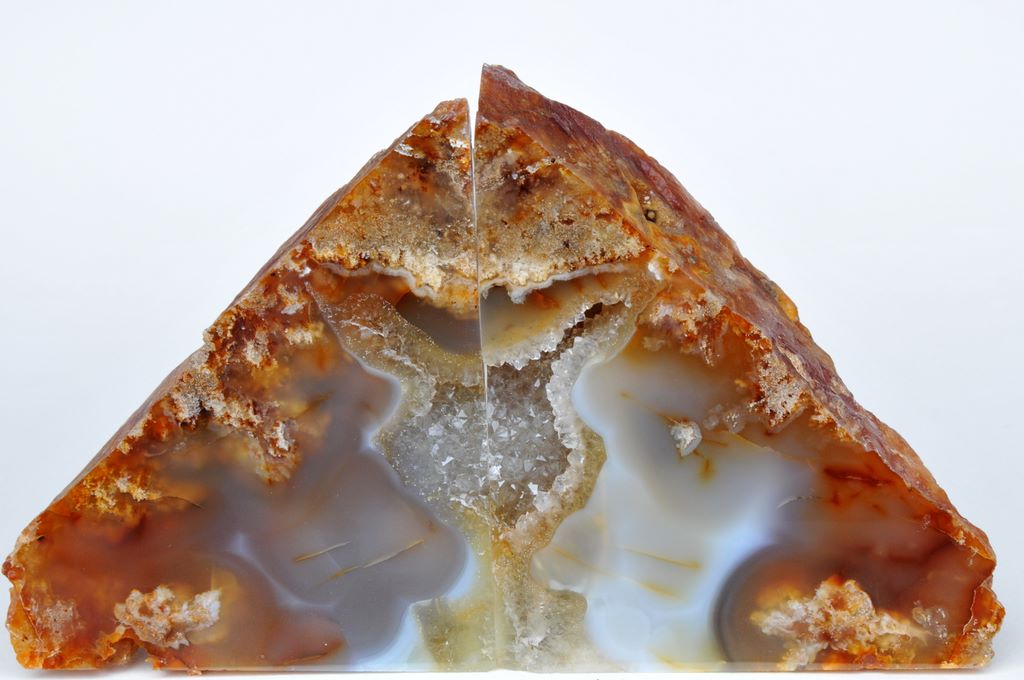
Triangular bookends cut from Lucas Creek geode. 5 1/2" tall.